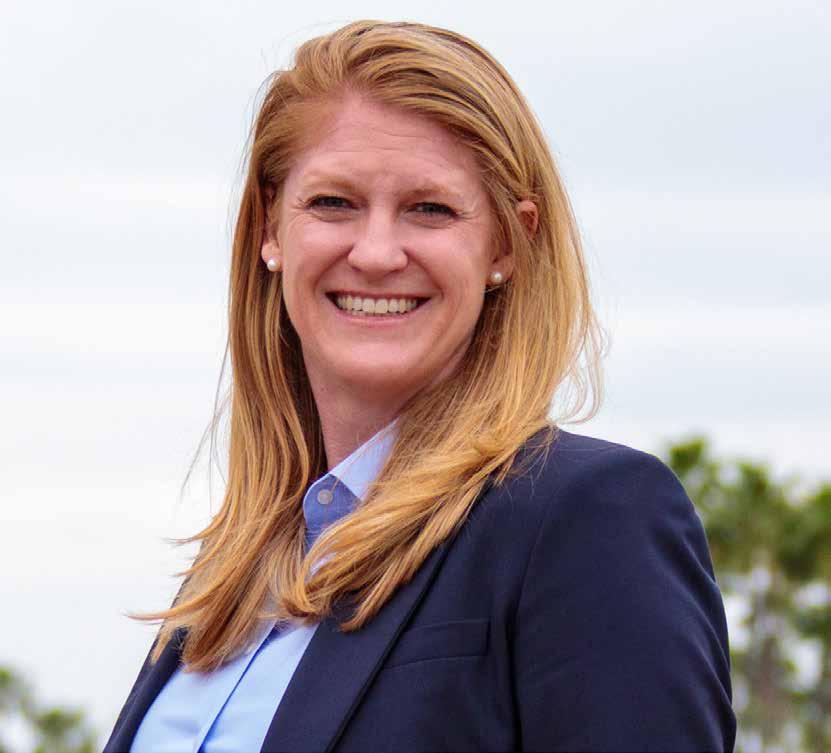

ASHDOD PORT CVC
Navigating
The Future
Israel's national port is proud to launch a venture capital fund that specializes in supply chain technologies.
Applications can be submitted starting February 15, 2025
We welcome start up companies to perform a PoC with commercial potential overseas. This is a story of entrepreneurial spirit, commercial infrastructure and one big ocean that connects the entire world.

for further details contact the Innovation Department: Roya@ashdodoport.co.il | www.blueocean-cvc.com

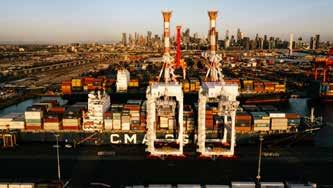
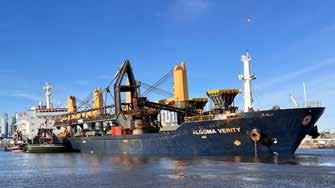
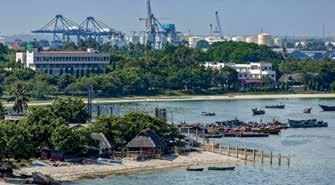
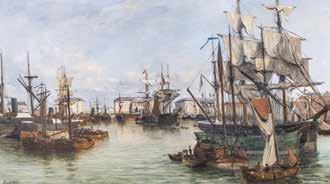
Providing thought leadership on the role of ports in a connected world
EDITORIAL & CONTENT
Editor: Martin Clark editor@ports-and-harbors.com
Features Editor: Felicity Landon
Publisher
Dr. Masahiko Furuichi
IAPH Secretary General info@iaphworldports.org
Dr. Patrick Verhoeven
IAPH Managing Director patrick.verhoeven@iaphworldports.org
Regular Correspondents: Felicity Landon; Ben Hackett Vladislav Vorotnikov
Production
David Blake, Paul Dunnington production@mercatormedia.com
SALES & MARKETING
t +44 1329 825335 f +44 1329 550192 Marketing marketing@mercatormedia.com
Chief Executive: Andrew Webster awebster@mercatormedia.com
Ports & Harbor magazine is produced and edited bi-monthly by Mercator Media Limited, Spinnaker House, Waterside Gardens, Fareham, Hants PO16 8SD UK
t +44 1329 825335 f +44 1329 550192 info@mercatormedia.com www.mercatormedia.com
Subscriptions
INTERNATIONAL ASSOCIATION OF PORTS AND HARBORS
IAPH members enjoy a free subscription to P&H. If your organisation is not a member and you would like a paying subscription to the magazine, please contact the IAPH for more information at: 7th Floor, South Tower, New Pier Takeshiba 1-16-1 Kaigan, Minato-ku Tokyo 105-0022, Japan
T: +81 (0) 3-5403-2770
F: +81 (0) 3-5403-7651
E: ph@iaphworldports.org
W: www.iaphworldports.org
©Mercator Media Limited 2024. ISSN 1740-2638 (print) ISSN 2633-4232 (online).
Ports & Harbor is a trade mark of Mercator Media Ltd. All rights reserved. No part of this magazine can be reproduced without the written consent of Mercator Media Ltd. Registered in England Company Number 2427909. Registered office: c/o Spinnaker House, Waterside Gardens, Fareham, Hampshire, PO16 8SD, UK.

EDITOR’S COMMENT

MARTIN CLARK Editor
Community and consensus
Ports have provided safe berthing for ships ever since the first vessels took to the seas many centuries ago. In the modern era, this concept of safe harbourage can be viewed in other ways too, not merely in the docking of a vessel by the quayside, but in the coming together of a community, a hub around which people, businesses, as well as ships, can thrive and work to a common purpose. This notion of collectivism, or growing together, has the potential to yield positive results for all. It is a theme explored in depth in this issue and one that has risen in prominence especially for landlord-model ports where the community role has become ever more crucial, perhaps even overtaking some of the more traditional roles a port may have fulfilled.
CONTRIBUTORS

KEVIN
GODIER
Freelance journalist
Kevin Godier is an independent journalist and the editor of International Trade Finance, the journal of record for trade finance markets, now publishing for more than four decades. He is among the leading commentators on the rise of non-dollarised global trade and a keen observer of current geopolitical trends. ■
It is a responsibility that means bringing stakeholders together and to act as a trusted focal point for the entire port community. That list includes businesses and other local stakeholders, as well as employees and people living around the port area. Ultimately, it is crucial for the port’s licence to operate and for it to grow in a long-term and sustainable manner. As the saying goes: teamwork makes the dream work.
There are plenty of examples in this issue illustrating how ports have helped drive such dynamic change and nurture prosperity for the communities they serve, from supporting small traders and entrepreneurs to championing the talents and work of local artists and artisans.
This focus on community building and creating economic opportunities was the topic of the first of the IAPH webinar series scheduled to run throughout 2025 and designed to share insight and best practice among the global ports community. You’ll find details of future webinars covering a wide range of subjects inside.
Supply chain resiliency is also very much a theme in the spotlight in this issue. Ports play a crucial role in boosting supply chain resilience by serving as key nodes for the flow of goods and materials between different regions. Against a backdrop of geopolitical challenges and trade uncertainty, however — from conflict zones to the threat of tariffs — it is important that ports once again work with all partners to keep the flow of goods moving.
Fortunately, ports will find receptive partners throughout the supply chain. In this issue, we hear from industry leaders from organisations such as the Global Cold Chain Alliance

Award-winning journalist Felicity Landon is a well-known figure in maritime circles, with the depth of knowledge and network of contacts to prove it. Felicity is versatile in her areas of coverage, with these spanning the container, dry and liquid bulk, cargo handling, energy and diverse other subject areas. ■
and RenewableUK. Without exception, all are keen to work more closely with the ports community to foster greater resiliency within the supply chain, whether that means moving frozen produce to consumers around the world or locating giant wind turbines offshore.
Global supply chains have proved adaptable time and again, responding well when challenged, which bodes well for any further uncertainty ahead ‘‘
There are reasons to be both encouraged and even to be proud in this collaborative endeavour. As the head of the Global Cold Chain Alliance, Sara Stickler, points out, despite immense media speculation and talk of potential disruption, rarely does this translate into actual interruption. Global supply chains have proved adaptable time and again, responding well when challenged, which bodes well for any further uncertainty ahead.
There is strength in numbers. Communication, collaboration and community — all are essential tools in navigating safe passage in the volatility of 2025. The IAPH remains a steadfast partner to both ports and other supply chain actors in that journey, as it has done for 70 years. Working together offers the best opportunity for all to thrive. ■
Get in touch with the editor: editor@ports-and-harbors.com

Dr HAYDN FRANCIS Consultant, UMAS
Dr Haydn Francis is a consultant at UMAS, specialising in operational and emissions trends, technology forecasting and Total Cost of Ownership (TCO) analysis, whilst also serving as the technical lead in UMAS’s advisory role to the Poseidon Principles and Sea Cargo Charter. ■
FELICITY LANDON Freelance journalist

IN CONVERSATION WITH SARA STICKLER
Cold chain collaboration
Appointed president and CEO of the Global Cold Chain Alliance (GCCA) last year, Sara Stickler is keen to encourage closer collaboration and engagement with the ports sector. Here, she talks to IAPH managing director Patrick Verhoeven about the challenges facing the supply chain in an era marked by rapid change and uncertainty.
MARTIN CLARK
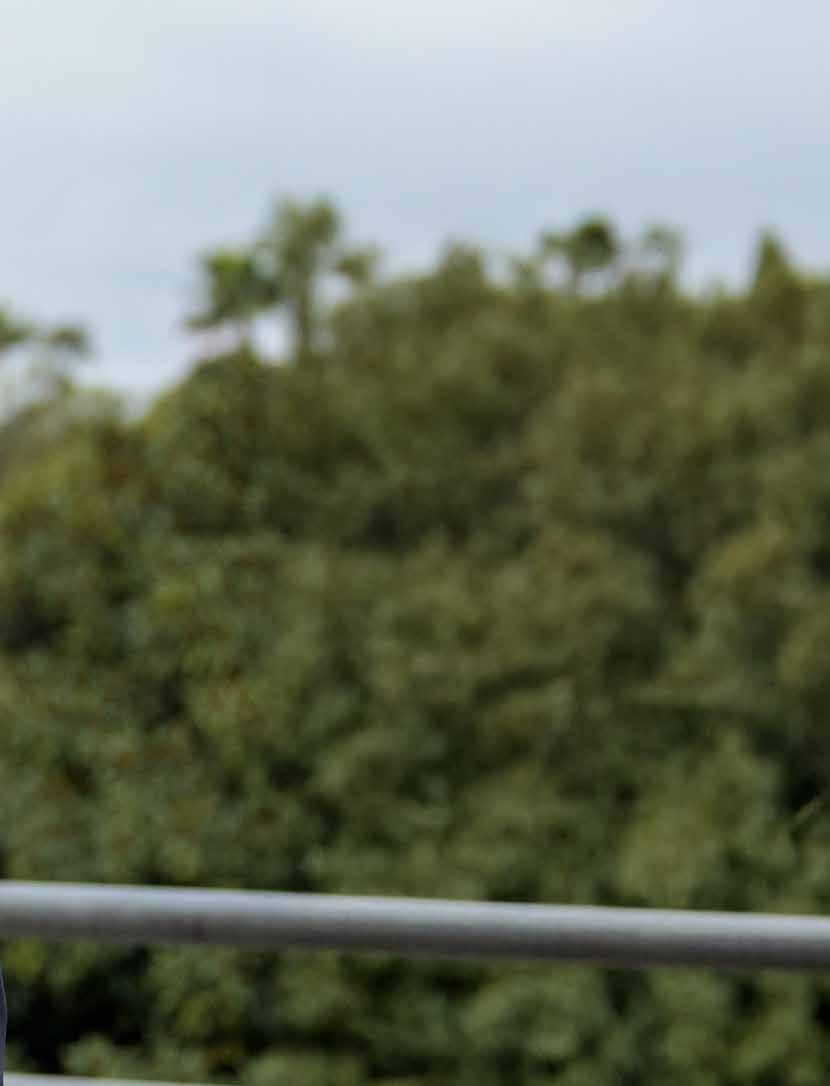
QSara (S) Can you give us an introduction to the GCCA?
S: The Global Cold Chain Alliance is an international organisation that brings together businesses that own, build and operate the global cold chain. Our Alliance is comprised of influential trade bodies representing third-party warehouse businesses, transportation and logistics, and controlled environment construction. We also operate the Global Cold Chain Foundation, which spearheads vital projects promoting cold chain development in emerging markets. Additionally, the Foundation organises our educational offerings composed of unique professional and personal development opportunities and technical training. As the voice of the global cold chain, we engage with government officials and policymakers in key strategic markets, notably the US, Canada, Latin America, Brazil, Africa and Europe. We work to educate these authorities on why the cold chain matters, how it works, and the importance of good policy decisions that will help all parts of the cold chain — public and private entities — thrive.
Q: What are your current priorities?
S: What I have learned after my first six months at GCCA is that through an array of external factors — including a global pandemic, consolidation, geopolitical dynamics, stressors in the supply chain and a growing population — our industry landscape is different today than it was even five years ago.
However, we are primed to respond and deliver, guaranteeing the growth, stability and success of our members as the trusted voice and acknowledged leaders in the global temperature-controlled supply chain. We are undertaking a future-focused strategic planning initiative in 2025, one that will provide a roadmap for ensuring access to the highest quality and safest temperature-controlled products and services for a universally strong cold chain.
Q: How do you or your members interact with ports?
S: Not only does GCCA have a number of ports in our global membership, but our members interact, serve, and collaborate with ports worldwide. These organisations benefit from being plugged into our cross-modal networks. The continued ‘blurring of lines’ between the different links in the cold chain are creating exciting global collaborations between port owners and warehouse operators. Further investment in a refrigerated infrastructure ecosystem will help harness the growth potential of cold chain, but it will require input from everyone to truly thrive.
One example of such collaboration is ports assisting cold chain operators to access cleaner energy. The Port of Antwerp-Bruges has invested significantly in its own clean energy generation, as well as supporting GCCA members in the development of their wind and solar solutions within the port.
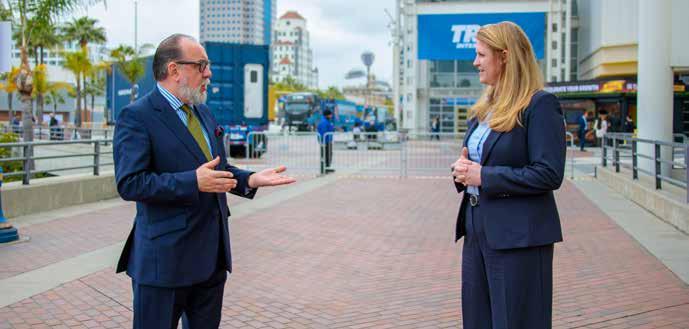
Cold chains have proved adaptable and able to solve problems. That bodes well for inevitable uncertainty ahead ‘‘
SARA STICKLER, CEO, GCCA
Q: How do you view the current world food supply situation?
S: I am in awe of the supply chain’s resiliency. There is a significant amount of media speculation and talk of potential disruption that does not actually translate into actual supply chain interruption. Whether it’s the collapse of the Francis Scott Key Bridge in Baltimore, the challenges in the Red Sea, or the disruption to the Panama Canal, cold chains have proved adaptable and able to solve problems. That bodes well for inevitable uncertainty ahead.
That said, disruptions have still taken a toll, especially on the people whose job it is to find real solutions to these challenges. In the supply chain, you get far more scrutiny for your failures than you receive praise for your successes — and our successes are great.
We certainly remain concerned about depressed consumer demand and changing volume demand due to, among other things, geopolitical disruptions. However, I believe we will navigate through these various challenges with the high level of adaptability and professionalism that our industry has exhibited in past situations.
Patrick Verhoeven (P): There is no doubt that this coming year will provide global supply chains – including the cold chain – with its sternest test when it comes to resilience. That is why it is vital to improve the visibility of cargo to BCOs in order for them to better plan for when disruptions hit. The new technologies deployed by the cold chain enabling traceability of cargo and the monitoring of its status needs to
be matched by the standardised exchange of ‘single truth’ data orchestrated between parties on this cargo. IAPH and its supply chain resilience taskforce, which brings together port authorities, carriers, terminal operators, port community systems providers, logistics and forwarding companies, aims at achieving this kind of transparency where data is shared, on a case needs basis between parties, in a secure manner.
Q: What are some of the main cold chain trends in 2025?
S: The cold chain has seen a significant amount of investment in the past decade or so, specifically warehousing. The rapid acquisition, consolidation and construction boom in developed economies, has led to an almost ‘generational change’ in the buildings and infrastructure we rely on. We have been able to match demand fairly successfully. We may see the pace slow with new economic uncertainties and the increasing cost of capital. So, while we do not predict a stop in investment, we are starting to see shifts.
The dramatic increase in the cost of energy, and uncertainties over energy supply over the past five years means that we need to think critically on how chain operators access, generate and consume energy. An increasing ambition to reduce carbon emissions, especially for the consumerfacing food brands, has brought with it major innovation and investment in more energy-efficient buildings and equipment. Similarly, fluctuations in the availability of labour in different parts of the world impacts investment. Technology has focused on how to make the workforce more productive which means greater use of automation — physically installed in warehouses and transport for loading and unloading, in process and software applications, and in other use cases.
Pictured: Patrick Verhoeven and Sara Stickler pictured outside a recent industry conference in Los Angeles Photos: Dustin Tuggle, Port of Los Angeles

At GCCA we are committed to invest in skills and career development. One programme we are proud of is our Cold Chain Institute, a training initiative designed for cold chain workers and middle management. The Institute celebrates its 60th anniversary this year, and we have expanded the programme to four continents. It’s a remarkable experience, and an important part of our overall mission.
Ports can support decarbonisation efforts through access to renewable energy ‘‘
PATRICK VERHOEVEN, MD, IAPH
Q: How important are sustainability and decarbonisation in your work?
S: Sustainability has been ingrained in our organisation from the outset. The invention of the cold chain is one of the most important sustainability developments of the modern era. Our Foundation also champions food waste intervention initiatives around the world. Our focus is on connecting logistics solutions providers to food redistributors, such as food banks. We have increasing success in helping ensure good food is saved and repurposed for those who need it.
I have already noted the millions of dollars of investment being made by operators across the world in energy efficiency and on-site renewable energy generation. This is driving significant sustainability outcomes and has been a big part of our members' ability to support their customers by meeting their 'scope 3' supply chain emissions reduction targets.
P: The best way that ports can support the decarbonisation efforts by the global cold chain community is access to renewable energy for the port’s operations. The introduction of onshore power for cargo vessels sourcing zero carbon energy, albeit it from wind, solar or hydro energy generation at any port around the world, will have a direct and positive impact on scope 3 emissions. The same applies to the electrification of materials handling equipment and decarbonisation of transportation, such as the increased use of rail. We are seeing this evolve rapidly in pioneering member ports in both developed and developing countries. We are even seeing some ports developing their own microgrids to meet this demand.
Q: How is innovation reshaping the global food supply chain?
S: I don’t know if I can point to a single, magic ‘game changer’, but instead to the incremental improvements occurring with
every new warehouse development, reefer design, or transport refrigeration system. In many ways, the cold chain succeeds if it meets simple requirements: building and equipment must be well insulated and carefully maintained; refrigeration systems must be well designed, carefully calibrated and focused on achieving the maximum efficiency possible; and the supply chain itself must be as densely utilised as possible, with goods turning and product handoffs kept as efficient as possible. What needs to be achieved stays somewhat the same, but the technologies and tools available change constantly.
Q: In what ways can ports support GCCA members?
S: Engagement. We know many of our members are already working with ports to deliver solutions, and we see these relationships continuing to grow. There is massive opportunity for expanded collaboration to provide efficiencies across the supply chain, and we welcome the chance to share best practices and create forums of shared knowledge and opportunities.
P: Creating opportunities to improve cargo flow through a port using technology and innovation is the best way that ports can support the global cold chain, from a sustainability as well as economic perspective. Through its recent publishing of the joint chainPORT report (bit.ly/chainPORTJIT) on how best to learn from pioneering ports’ efforts to optimise a port call right through to releasing guidelines on how ports can implement a strategy to become more resilient to internal and external risks (bit.ly/3X6PCaX), IAPH aims at ensuring its members can serve the cold chain in a better way.
Q: What would be your final takeaway message?
S: Temperature-controlled products are only a small percentage of the volume that moves through ports, but we know it is one of the more exciting and complex parts of the operation. There is so much potential for shared success between the ports sector and the wider cold chain, especially as both sides look to make plans and investments that will help to keep our food supply resilient in the decades ahead. As we look at a more integrated supply chain, GCCA and port cooperation and collaboration will be instrumental for generations. I look forward to being a part of this friendship. ■
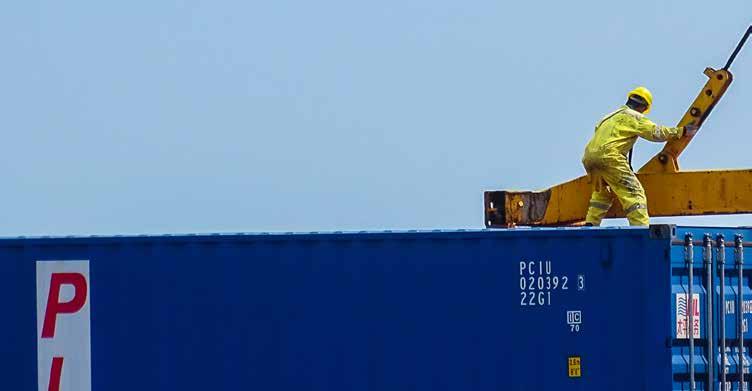
PERSPECTIVE PORT INSURANCE
Resilience from risk transfer
It is tough for any port to build resilience – to remain an open channel helping build growth for others, exposed to many risks, and yet still be optimal and grow. We all understand businesses exist to grow, but an enterprise’s understanding of risk often determines the limits of its growth. For port enterprises to thrive in this environment a sound enterprise-wide risk-management framework is essential to secure growth. This means considering risk transfer as a core part of the whole enterprise.
The top five risk management factors underwriters will be assessing are:
● What are the prevailing market conditions?
● What’s the catastrophe (CAT) exposure?
● What’s the assured’s risk appetite?
● What’s the total cost of risk?
● Is a comprehensive risk management framework in place?
● What’s the loss record?
For the past few years, insurers have been reducing the capacity deployed on exposure to locations where catastrophes – such as floods, storms, tornadoes – are becoming more prevalent, specifically in and around the Gulf of Mexico. Capacity can also be heavily influenced by an insurer’s aggregated exposure in a specific CAT-exposed region, where they may insure other risks possibly equally affected by the same CAT event.
In some instances, insurers came off CAT exposures completely after suffering large losses. Insurers were increasingly seeing historical ratings as inaccurate for today’s risk conditions.
Usually, significant losses from natural catastrophes would prompt larger increases in insurance rates.
The ports and terminals (P&T) insurance markets were not found to have incurred significant losses from natural catastrophes in 2024, according to WTW’s Marine Market Liability Update (published in September 2024).
Most increases were attributed to inflationary pressures on claims (for example, for raw materials, transport, etc.) during the year.
Stable year
In general, 2024 was a stable period for CAT-related claims, one in which premium increases on ports and terminal policies were lower than those in previous years.
With insurers’ portfolios now largely corrected, rate increases for 2025 are currently expected to reflect those from the past 12 months (i.e., from 2.5% to 7.5%) if the buyer’s exposure has remained consistent and no claims were filed in later years.
With the conditions that created
Pictured: Ports must work closely with brokers and other experts to manage evolving risks
Photo: Zulkiffle Mohd Kassim | Dreamstime
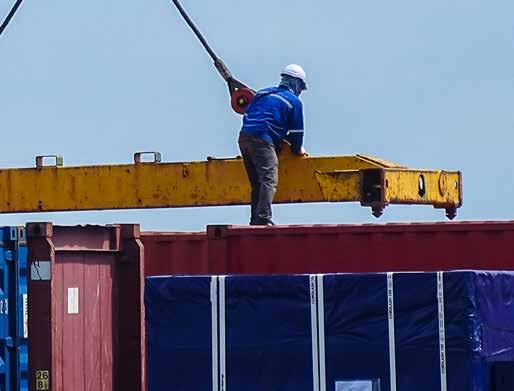
increases now on the wane, insurers are moving back to assessing and rating renewals on an individual basis. In addition to this, the last few months have seen some new capacity enter the P&T arena.
This is both from the aspect of established insurers participating in P&T business, which they had not done previously, and from completely new insurer set-ups (MGA’s) specifically aiming to write P&T business. The result is likely to push rate increases to the lower end of the scale.
In general, 2024 was a stable period for CAT-related claims ‘‘
Although their presence in high CATexposed regions can still affect the level of rate increases, ports and terminals who can show insurers their risks are being well managed stand a greater chance of premiums being proportionately rated.
Guided by their insurance broker, a port’s risk executives will be able to systematically consider risk exposure, risk appetite, total cost of risk, cost efficiencies and coverage. Often a panel of insurers, risk engineers, claims executives and loss adjusters are consulted throughout the risk management
process. During this period, policy terms – including deductible structures, detailing the assured’s retained risk – will be reviewed. Sometimes this results in prospective policy buyers providing more in-depth underwriting information.
This structured approach helps create a well-informed business enterprise. For the best outcome, this approach needs C-suite executives talking to all risk stakeholders – treasury or finance officers and insurance risk managers, and the risk managers of specific business divisions — say, the CISO, for a port’s cyber risk transfer, as well as health, safety, security and environmental managers.
Connected approach
This connected approach also helps to prevent losses. Loss prevention assessments and actions help to give insurers confidence an organisation not only understands its risks, but it is also managing the risks within its control.
At the same time, clear evidence of a port’s investment programme (such as new equipment or property upkeep) also provides confidence to insurers as to how a port may view its own risk exposure.
Resilient port enterprises not only manage risk, but continuously review to optimise the transfer residual risk off

ABOUT THE AUTHOR
PETER YATES is a marine insurance broker at Willis. Previously, he worked as a project design engineer for an offshore energy contractor, focusing on industrial design risk management for blue-chip energy clients’ large capex projects. His early career was in product design, manufacturing production management and risk assessment in the defence and security industry.
their balance sheet. Enterprise-wide risks need to be considered on a continuum; they change in scale and priority. The framework will need to flex to changes in risk levels, and new risks as they emerge. If they do this with an insurance broker, then by measuring the total cost of risk and their risk appetite, they can define a clear and optimal risk transfer programme.
Insurance can help to transfer common classes of P&T risks, when aligned with a port’s goals and risk tolerance. These include property, business interruption, port blockage, collision or allision, labour strikes, civil unrest, cyber or geopolitical events.
Simply put, when port enterprises display an ability to describe risk through a structured risk management process, so insurance premiums might be better rated. It sounds simple but, in practice, too many businesses do not have a best practice risk management framework in place or fully capture the rich risk insights held within their own organisations.
Risk pervades any organisation and although the nature of perils faced by ports may endure, exposures most certainly evolve, so I advocate any port enterprise remaining in very close touch with their broker’s teams of experts. ■
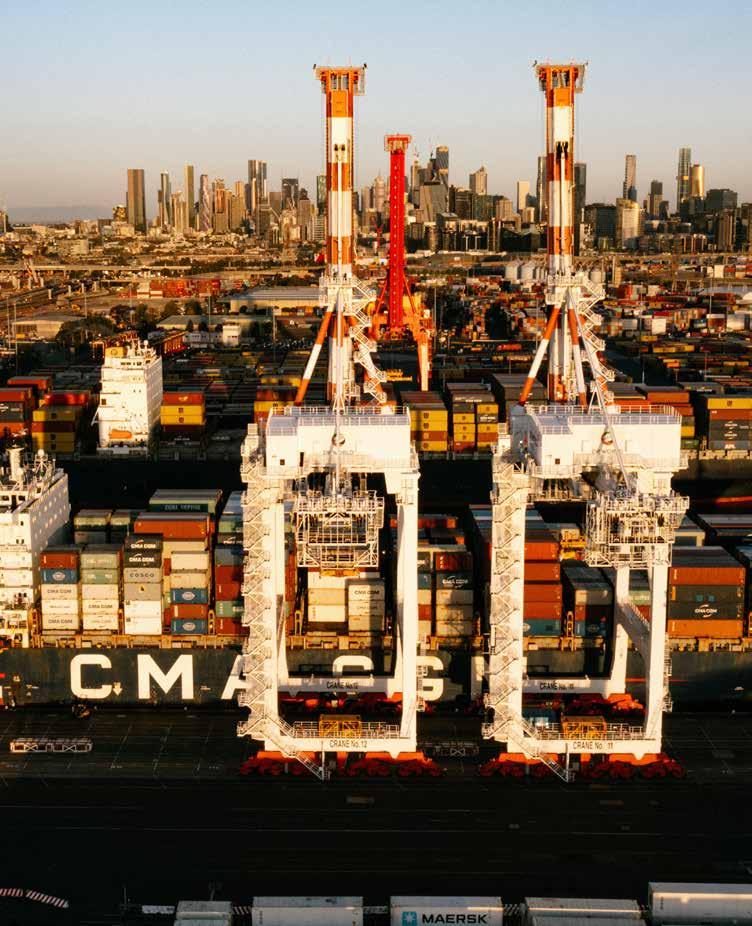

Nurturing a thriving port community economy
What happens inside the port gates may be a mystery to many on the outside. But what happens matters: to the people, cities and regions outside, and far beyond, in the economic opportunities that ports are able to generate both for themselves and for the communities they serve
FELICITY LANDON
No port is an island – it must operate as a partner, member of the community and generator and supporter of economic growth.
The Port of Melbourne is a prime example. One of the State of Victoria’s most significant public assets, facilitating more than A$153bn (US$97bn) of trade moving across the docks every year, the port is also one of Victoria’s largest investors. It is currently playing an active role in an industry stakeholder reference group for the ‘Victorian Freight Plan refresh’, noting that Melbourne is projected to become Australia’s largest city by the mid-2030s, so prioritising new infrastructure and capacity upgrades is essential.
“We have invested more than A$800mn (US$509mn) in the port’s development and operations since taking the lease in 2016. Not only do we expect to make significant further investments in the port itself, but we also want to see the supply chain operating efficiently and meeting the demands of growing markets,” says CEO Saul Cannon.
“We are very keen to work with the Victorian government to understand and plan for regional market changes, to support our exporters through efficient infrastructure and to facilitate the international relationships that can offer opportunities to Victorian businesses.”
The economy and community depend on the port to keep goods moving, he says, and it is imperative that it operates alongside business and community. It has been engaging with stakeholders for its Port Capacity Enhancement Programme (PCEP) and there is wide-ranging engagement with industry, government, community and other interested parties to develop a 2055 Port Development Strategy (PDS).
The port contributes more than A$11bn (S$7bn) to the Australian economy annually and supports more than 30,000 full-time equivalent jobs. It participates in a number of industry bodies promoting economic development and transport network collaboration, and sharing knowledge and advocating on infrastructure development and supply chain issues. It also sponsors and supports industry awards and conferences.
“Without collaboration and positive relationships with our tenants, success would be difficult to achieve,” says Cannon. “Internally, we have worked towards building customer-centric tenant relationships, while operating as a multi-property landlord port manager in line with other commercial and industrial sector leaders.”
Pictured: Australia’s Port of Melbourne is prioritising collaboration and positive relationships with its tenants as well as the wider community it serves Photo: Port of Melbourne
The port recently secured a long-term lease agreement for the former Melbourne Markets site, which it says will provide new space for port functions, truck parking, container storage and other uses, while also reducing congestion. Container volumes at the port are expected to double by 2050, so the land is critical to future needs.
The port also supports and engages with the surrounding community, says Cannon. For example, providing and maintaining more than 18 hectares of public open space and 27 km of walking and cycling trails, donating time and resources to charities and not-for-profit organisations such as Foodbank Victoria, the Mission to Seafarers, Stella Maris seafarers’ centre and Williamstown football club, and operating boat tours. Its port education programme hosts more than 1,250 schoolchildren each year.
provide 1,400 direct jobs and approximately 1,600 indirect jobs in the supply chain and local businesses.
“The Viking CCS project provides the UK with the opportunity to become a significant player in internationally shipped sequestrated carbon. It will create opportunities for highly skilled local employment – 10,000 new jobs and safeguarding existing high-value industrial jobs.”
Where will the skills and people be found? “There are several local initiatives training people to go into construction, which will be essential for such large infrastructure development, and then also for some of the key ‘end user’ sectors like process industries and offshore energy,” he explains.
Collaboration with local communities, government agencies and industry stakeholders is critical to delivering long-term benefits for Papua New Guinea
“We believe we have come a long way, right throughout the business, in being able to demonstrate ourselves as a good corporate citizen,” adds Cannon.
A double mission
In the UK, Associated British Ports’ (ABP) mission for many years was: Keeping Britain Trading. “However, last year we added a second mission – ‘Enabling the Energy Transition’ – to reflect the growing role of green energy and industrial decarbonisation activities in the business,” says Tim Morris, ABP group head of corporate communications. “To ABP, these missions are equally important – providing gateways for trade but also providing vital infrastructure for large-scale clean energy projects.”
More than 200,000 jobs are supported by ABP and its customers in the UK supply chain, says Morris. “Our additional clean energy projects have the potential together to generate thousands of good, sustainable jobs.”
ABP describes the Humber, where it operates the ports of Immingham, Grimsby, Hull and Goole, as the UK’s Energy Estuary. Greenport Hull, the Siemens Gamesa offshore wind turbine manufacturing, assembly and servicing facility built in partnership with ABP, was opened in 2017, creating more than 1,000 new local jobs and many more in the supply chain.
On the south bank, the Immingham Green Energy Terminal has just been granted development consent. IGET incorporates two key elements: Air Products’ green hydrogen project and facilities to serve the Viking carbon capture and storage (CCS) project.
“The Air Products green hydrogen project will bring a wide range of benefits to the UK and the Humber, including eliminating up to 580,000 tonnes of GHG each year, the equivalent to taking 20,000 diesel HGVs off the UK’s roads,” says Morris. “It will reduce NOx emissions and improve air quality. In addition, the project will bring up to £3.65bn (US$4.6bn) in growth and financial benefits to the region, and
“Having enough people to do these jobs is vital. These tend to be high-skilled jobs that are well paid. We must sow the seeds as early as possible to make sure that workforce is available – and initiatives on the Humber like CATCH are good examples of this happening in practice.”
ABP’s Lowestoft Eastern Energy Facility (LEEF), officially opened in January, has been built to meet the growing demands of the offshore energy industry, supporting operations and maintenance (O&M) activities and construction.
“This transformative £35m (US$22mn) project is key for further developing the town’s leading role as a hub for offshore energy,” says Morris. “For a town like Lowestoft, projects like this really matter. LEEF is a good example of how ports can be engines for regeneration of coastal communities.”
Community participation
Philippines-based International Container Terminal Services, Inc. (ICTSI) made a commitment to ensure local community participation in port operations when it signed concession agreements with Papua New Guinea Ports Corporation (PNGPCL) for operations in Lae and Motukea ports eight years ago.
This included allocating 30% equity in each terminal to the respective impacted community groups, an arrangement consistent with PNG government policy to encourage local content in all major economic projects.
ICTSI South Pacific Ltd (ISPL) entered into a share subscription agreement (SSA) with the community groups, providing an initial loan equivalent to 30% of the total start-up costs of each terminal, explains Robert Maxwell, CEO of ISPL. “This loan was structured to be repaid through a 70% retention of the quarterly dividend flows, ensuring a sustainable financial model for community ownership. By 2022, these loans were fully recouped, and the share certificates were officially transferred to the community shareholder companies.”
This arrangement has enabled the establishment of trusts that channel quarterly dividends into community projects aligned with the United Nations’ Sustainable Development
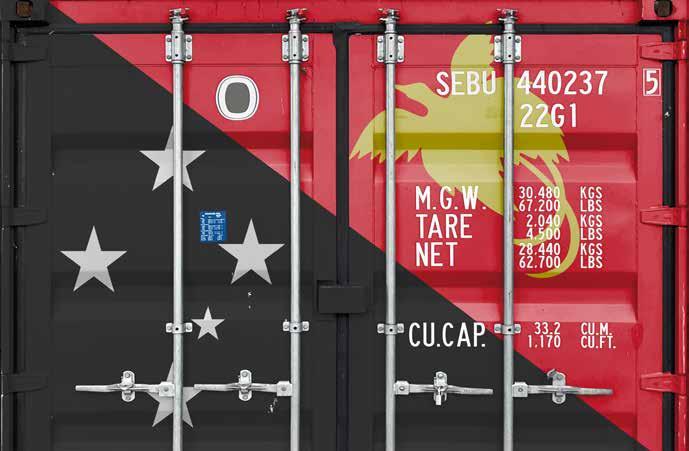
Goals, focusing on health, education, clean water, decent work, economic growth and climate action.
“Collaboration with local communities, government agencies and industry stakeholders is critical to delivering long-term benefits for Papua New Guinea,” says Maxwell. “By working together, we can continue to drive sustainable growth, build local capacity and enhance the prosperity of the communities we serve.”
More than 500 local people are employed by ISPL, representing over 85% of its workforce. A training facility opened at the South Pacific International Container Terminal (SPICT) in Lae is equipped with US$100,000 simulators. “The centre aims to develop world-class talent by providing comprehensive training for port equipment operators and engineers. This initiative reflects the company’s commitment to capacity building and operational excellence,” says Maxwell.
ISPL has also set up an international training exchange programme. In August 2024, a training initiative for the engineering team of Visayas Container Terminal was held at MIT and SPICT, focusing on mobile harbour crane operations, safety protocols and technical maintenance. In addition, two mobile harbour crane operators were sent to Mindanao Container Terminal (MCT) in the Philippines to boost the productivity at the terminal and train their Filipino counterparts. ISPL carries out more than 20,000 hours of staff training per year. This has led to a reduction in expat employees from 21 to six, as Papua New Guineans move into senior management roles.
Among community projects, ISPL constructed two police stations in Lae, built an elementary school building in Labu Miti village in Lae and expanded a primary school in Motukea, continuing to provide annual donations of schools desks, bags and stationery to two schools. It collaborated with Water PNG Ltd to improve water pressure in Motukea, including the installation of two 146,000-litre galvanised water storage tanks, and donated two container trucks to Motukea residents to support a business delivering full containers to and from the terminal.
Other projects include the planting of mangrove trees, Annual Environment Day events educating students on sustainability, the inclusion of community members in annual Safety Day events, and the provision of staff buses for safe transport and provision of hot meals twice a day at the terminal canteen. ■
Read more: For further reading on this topic please visit our coverage of the first in the 2025 IAPH webinar series — Creating Economic Opportunities For the Port and the Community — on page 15 in this issue. Further details of upcoming webinars can also be found on page 14.
Pictured: In Papua New Guinea, ICTSI South Pacific Ltd (ISPL) runs an innovative equity share programme to give community groups a stake in local port terminals
Photo: Mykhailo Polenok | dreamstime
Connect, listen and learn
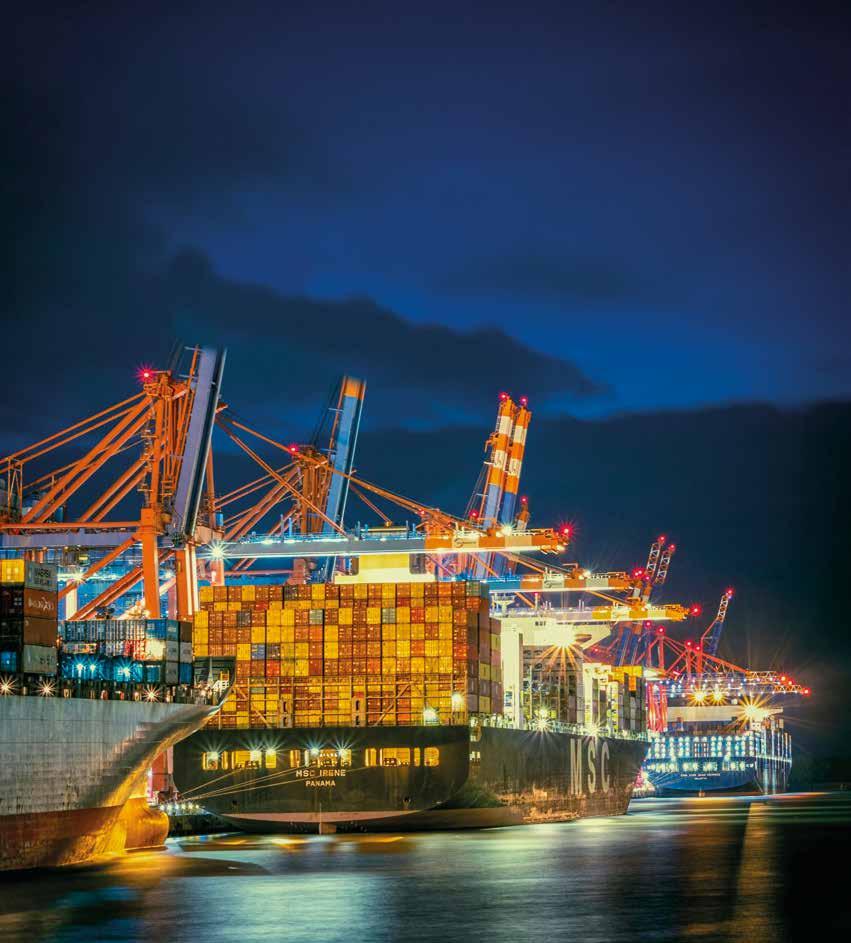
MAY 14
10:00 CET / 17:00 Tokyo
How to deal with port infrastructure adaption challenges with both extremes: folding and drought
JUNE 25
17:00 CET / 08:00 PST
How can we expect quantum computing and AI to impact port cyber security?
SEPTEMBER 3
10:00 CET / 17:00 Tokyo
Upcoming crucial IMO MEPC decisions in 2025 - how they will impact ports
DECEMBER 3
17:00 CET / 08:00 PST
Investing in port decarbonisation infrastructure - managing risk
Our well-established IAPH-Mercator webinar series is back in the lead up to the World Ports Conference, taking place 7-9 October in Kobe, Japan. Open to members and non-members, register now to learn about key matters and challenges arising in the ports industry.
Partnerships for prosperity
P&H looks at some of the highlights from the first of the 2025 IAPH-Mercator Media webinar series, exploring how ports can engage with communities to foster mutually beneficial economic activities
To view a recording of the webinar visit: bit.ly/3DsxdRz
The theme of creating economic prosperity together — between ports and the communities they serve — was explored via a series of case studies during the first of the IAPH-Mercator Media webinars that are scheduled to run throughout 2025.
A common thread was the need to build enduring partnerships, based on trust, with a shared desire to bring prosperity to all in and around the port region.
Australia: Port of Brisbane
Craig Wilson, head of sustainability at Port of Brisbane, shared details of a recent A$270mn (US$168mn) investment into a new cruise terminal, which has brought with it benefits and opportunities for the whole community, as well as for the port and the city and region it serves.
Built in response to growing cruise traffic in the mid-2010s, Brisbane International Cruise Terminal has created new tourism infrastructure to grow Queensland’s cruise industry, including the ability to accommodate larger vessels. “For every cruise visit, we generate approximately A$1mn from passengers alone,” said Wilson.
With a focus on sustainability, the project included reusing materials to minimise waste and an 800kW rooftop solar system to provide shaded car parking for passengers and trim the terminal building’s energy draw from the grid. One unique feature is the indigenous artwork featured at the terminal, a reflection of how the port was able to bring in all stakeholders across the community. Wilson said engagement and collaboration with the cruise industry, government, local residents and other stakeholders was essential for the project’s success.
The main takeaway? Take a bit of risk with your project and your outreach. Wilson said the terminal is already nearing its capacity and that there is demand for more. “The key takeaway here is the massive success we’ve had.””
Benin: Autonomous Port of Cotonou
Transforming livelihoods for the vendors making their living around the Autonomous Port of Cotonou is the standout success from this story — a winner of an IAPH Sustainability Award in 2024.
Bart Van Eenoo, chief executive of Autonomous Port of
Cotonou, and Brunette Rosine Sounkoto, sustainability manager, shared details of this extraordinary project initiated by the port authority, that is now yielding life-changing results.
The project supports local vendors around the port area at a new site that opened in February 2024 offering better, safer facilities including stores, sales kiosks, halls and hygienic kitchens.
Though subsidised, and sited on port land for now, the long-term goal is to give it back to the vendors to assume ownership.
It was essential to get ‘buy-in’ from all stakeholders first, according to Van Eenoo, to build trust and to reassure the vendors. The area also includes a striking 1.4 km painted wall (soon to be 2.5 km) fully decorated by local artists, creating a high impact social and cultural landmark.
“It’s becoming quite a tourist attraction,” Van Eenoo noted.
It’s a question of getting everyone involved and, of course, you need to have a project champion. Be proactive and be ready to ‘jump in’ when called upon
Dato’ Azman Shah Mohd Yusof, MMC Port Holdings Sdn Bhd
Malaysia: Northport
The Circle of Life project is a vertical farming initiative led by Northport (Malaysia) Bhd as part of its overall environment, social and governance commitments. It aims to enhance community engagement, promote environmental sustainability and boost local food security.
The scheme now supports the area’s schools, helping children learn about farming, as well as supplying local firms and traders with fresh produce. There is an emphasis on sustainability throughout, with solar-powered pumps and the production of fertiliser through food waste.
Community engagement was equally important to this project, according to Dato’ Azman Shah Mohd Yusof, chief executive of MMC Port Holdings Sdn Bhd.
“It’s a question of getting everyone involved and, of course, you need to have a project champion,” he said. Be proactive and be ready to ‘jump in’ when called upon, he added. ■
Book your place today
Conference speakers include:

Director General, Spanish Shipowners’ Association (ANAVE) & President, Spanish Shortsea Promotion Center
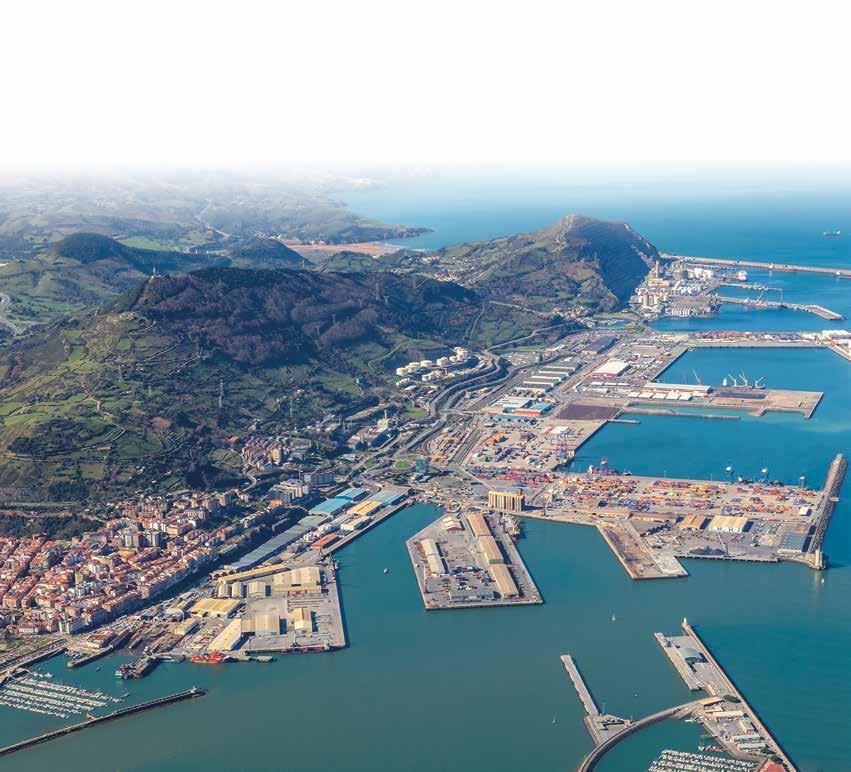
Supporters:




Topics include:
Renaissance of Short Sea Shipping OPS Expansion: Increasing the pace to meet demand
Infrastructure development at ports to support short sea shipping
Expansion of green and digital corridors ETS Carbon Levy What do Shippers Want?


Coastlink is a neutral pan-European network dedicated to the promotion of short sea shipping and intermodal transport networks. Learn from and network with international attendees representing shipping lines, ports, logistics companies, terminal operators, cargo handlers, and freight organisations.
For more information on attending, sponsoring or speaking contact the events team:
visit: coastlink.co.uk
contact: +44 1329 825335 or email: info@coastlink.co.uk






Group Commercial Director, Peel Ports Group
Andima Ormaetxe Bengoa, Director for Operations, Commercial, Logistics and Strategy, Port of Bilbao
Stefan Krattiger, Business Development Leader Global Ports, Supply Chain Operations, IKEA Supply AG
Alexander Prahl, Head of Sales and Contracting Trademanagement, TAILWIND Shipping Lines
Media supporters:

KEVIN GODIER Editor, International Trade Finance
Wake-up call
Kevin Godier highlights the role of Islamic financing among the trends shaping port and infrastructure finance today
While sustainability, decarbonisation and even diversity initiatives continue to steer infrastructure spending among global lenders, Islamic financing too has become significant to the ports sector.
This is not new. For years, Islamic financing has been supporting various high-profile projects, such as King Abdullah Port, Saudi Arabia’s first fully privatelyowned port.
What it has done is accelerate port infrastructure and related supply-chain investments, not just across the Middle East, but also globally.
In this sense, Islamic products are playing an integral role in connecting funding gaps to facilitate major supply-chain projects of regional, and international, significance.
In 2023, for example, DP World raised US$1.5 billion in Green Sukuk financing to support sustainability initiatives across its global portfolio, underling its impact beyond the Middle East.
Notably, the Sukuk, an Islamic product, similar to a bond in Western finance, was oversubscribed due to strong demand and has since been listed on both Nasdaq Dubai and the London Stock Exchange.
Islamic finance is now underpinning other supply chain projects of global strategic importance.
Last year, a US$2.5 billion rail network project connecting the UAE and Oman secured a US$1.5 billion financing from a consortium of local, regional and global lenders.
It is a strategically-important project for the region
and the world with the railway connecting to the Sohar Port and free zone in north eastern Oman, bypassing the narrow and congested Strait of Hormuz, the world’s busiest energy shipping corridor.
Analysts commonly say that if the Strait of Hormuz is shut down, the world economy shuts down.
The 238-km project stretches from Abu Dhabi’s Al Wathba area to the Omani city and port of Sohar and will boost trade and connectivity between the Gulf states, linking five major ports and various industrial and free zones across the two countries.
The region’s first cross-border railway, the goal is to connect not only Sohar, but also link up with the major UAE ports of Jebel Ali, Khalifa, Ruwais and Fujairah.
First contracts for the project were recently awarded to the Indian conglomerate Larson & Toubro and Chinese state-owned Power China.
The funds for the Hafeet Rail scheme will be drawn in both conventional and Islamic tranches in UAE dirhams and Omani rials, according to one of the project’s sponsors, Etihad Rail, which is working alongside Oman Rail and Mubadala Investment Company.
In keeping with global funding trends, there is a climate mitigation impact as well, with the freight trains expected to reduce carbon emissions significantly compared to other transport means.
A single freight train journey on the network is expected to transport more than 15,000 tonnes of cargo, or approximately 270 standard containers.
Most importantly, it opens a vital new trade gateway outside the Strait of Hormuz choke point. ■
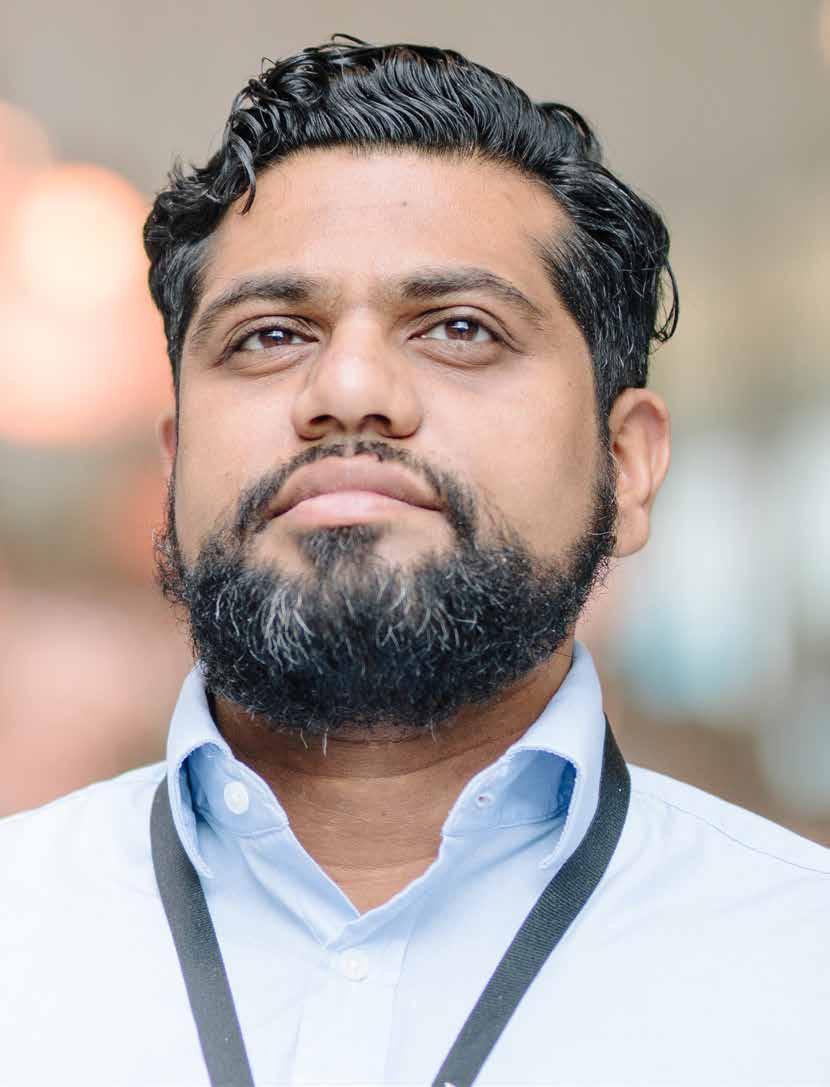
Ajai Ahluwalia
Ajai Ahluwalia is a key figure in the UK’s renewable energy space and how it interacts with the ports sector, as part of his supply chain remit. With a technical and strategy background, he’s worked on the design and build of flagship projects like Dogger Bank, now among the world’s biggest offshore wind farms, which sits in the North Sea shallows.
In terms of installed offshore wind capacity, the UK is second in the world only to China in what is a rapidlyexpanding sector. Global capacity of fully operational offshore wind farms reached 80.9 gigawatts (GW) in February 2025, up from 70.2GW just 12 months ago, an increase of 15%.
As head of supply chain at RenewableUK, Ahluwalia is clear about the role ports have to play in this energy evolution. In February, the trade association delivered its annual Ports & Vessels conference where there was a call for immediate investment in ports to enable the supply chain opportunities associated with the UK’s offshore wind ambitions. RenewableUK also runs a ports and maritime working group to explore and realise this opportunity.
Onshore and offshore wind projects are inherently linked to ports. “I look at this very much through the prism of supply chain,” he says. “We fundamentally rely on global supply chains. One of our priorities now is how to make sure the UK can access those supply chains, and the associated economic opportunities, of which ports are a critical part.”
But what about the current state of the global supply chain, given current volatility? “That’s something we’re keeping a close eye on. I think consistency in tariffs is an important issue and obviously we’re in a dynamic situation at the moment. This uncertainty adds risk to projects — where risks translate to increased costs. So we’re in a situation right now where people are considering where their components and services are coming from and we’ve got to be cognisant of that.”
Head of supply chain at RenewableUK, Ajai Ahluwalia underlines the essential role ports must play if the world is to make a successful transition to clean energy
MARTIN CLARK
Investments & opportunities
RenewableUK has set out its strategic priorities in an Industrial Growth Plan for offshore wind, which sets out how to triple offshore wind manufacturing capacity over the next 10 years, supporting an additional 10,000 jobs a year and boosting the UK’s economy by a further £25bn (US$32bn) between now and 2035. It also recognises how innovative hybrid solutions allow offshore wind to combine with new technologies, such as green hydrogen, strengthening the security and flexibility of a modern energy system.
Yet it all comes back to supply chain fundamentals, says Ahluwalia. “Ports are an essential piece of that infrastructure; we’re all part of the same industry. But timing is everything. If we want to realise the economic benefits of offshore wind then we’ve got to make sure the infrastructure is in place first. This means having ports that have the space, the personnel, the cranes and locations to be available as these mega projects ramp up.”
of the mix, so creating a long-term and strategic vision for ports is key.”
Floating offshore platforms
Though the profile for each port might look different, depending on its size, ownership and access to capital, these points ring true across the sector. “The timing of investment in ports is crucial, because if we don’t get the ports in place, we don’t get the manufacturing and service providers, and then we’re going to lose the opportunity to serve those projects in the coming decades.”
Ports are an essential piece of that infrastructure; we’re all part of the same industry. But timing is everything ‘‘
Those opportunities include the prospect of huge floating platforms the size of a football pitch each hosting a giant turbine, something that could only be built in a port setting. It is a concept that organisations such as Associated British Ports are exploring for Port Talbot, to become a central hub for the manufacturing, assembly and integration of floating offshore wind projects in the Celtic Sea.
When it comes to timing, however, new projects and factories all hinge on an array of factors, notably the ability to make a return on investment which, in the ports sector, can be longer term. Strong political and economic support can be a determining factor in success.
“None of these things happen unless there’s confidence in the pipeline of orders or revenues,” says Ahluwalia. “So the model for ports to consider is how are they making their money: is it by leasing land to manufacturers, with facilities on the quayside, or is it revenues they generate by moving goods in and out of the port? It’s all part
In relation to floating offshore wind, as well as fixed foundation turbines, one ongoing industry conversation, Ahluwalia says, is at what point do we stop focusing on designing larger turbines and start deploying at scale? Constantly seeking lower project costs through larger turbines means it will be harder to realise cost reduction through mass deployment. “This is crucial for installation vessels as well as port design. So, in some ways, one of the big questions we have is confidence — confidence for ports and developers to invest their capital and confidence in the designs they have for their future assets.” ■
FEATURE PORT CONGESTION
Quantifying port congestion
Finding solutions for tackling port congestion and other long-standing inefficiencies may also offer a route to maritime decarbonisation
Dr. HAYDN FRANCIS, CONSULTANT, UMAS
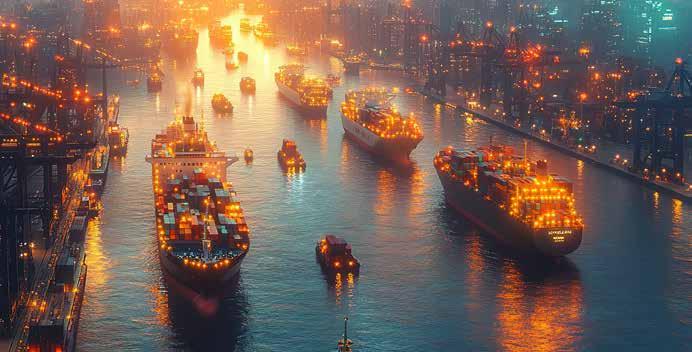
As the shipping industry continues to play a pivotal role in global trade, it faces a dual challenge, as it seeks to address inefficiencies that have persisted for many decades, at the same time as meeting the increasingly stringent decarbonisation targets set by the International Maritime Organisation (IMO). Achieving these objectives is crucial for shipping's transition to a low-carbon future.
Among the systematic issues under scrutiny, port congestion and pre-berth waiting times stand out as key contributors to voyage inefficiencies and vessel emissions. UMAS recently published a report, titled ‘Port Congestion, Waiting Times and Operational Efficiency’, which highlights the potential for significant greenhouse gas (GHG) reductions by optimising these processes.
Long port waiting times are a well-understood consequence of the near-ubiquitous ‘first-come, first-served’ scheduling policy at ports and the ‘sail-fast-then-wait’
practice. These practices are entrenched by factors like inadequate data standardisation, inflexible charterparties and poor coordination of relevant stakeholders (for example, port authorities, cargo owners and ship operators). The study quantifies the fleet-wide inefficiency caused by port waiting from 2018–2022 and its associated emissions, identifying pre-berth waiting times as a substantial opportunity for GHG reduction in the near-term with low capital expenditure.
The results highlight the surge in port congestion and delays caused by supply chain disruptions during Covid-19. These pandemic-driven bottlenecks intensified a broader trend of increasing port waiting times from 2018 to 2022,
Pictured: Tackling port congestion could aid the industry’s decarbonisation drive
Photo: ID 348835454 | MisterTigga | Dreamstime.com
underscoring the need for more resilient and adaptive shipping operations.
Addressing this issue holistically, rather than simply excluding port waiting emissions from the Carbon Intensity Indicator (CII) metric, is critical for unlocking this potential. Excluding these emissions from the calculation risks perpetuates inefficiencies and misses a cost-effective opportunity to advance toward decarbonisation goals. Ultimately, tackling the challenges surrounding port congestion and waiting times is a facet of the systemic change and collaboration that will be essential for the maritime industry to meet the ambitions of the IMO's Revised Strategy.
The current landscape
Port congestion and waiting times at anchorage prior to berth have long impacted maritime operations. Between 2018 and 2022, ships spent an average of 4-6% of their operational time — equivalent to 15-22 days per year — waiting at anchor. This inefficiency varies by vessel type, with chemical tankers experiencing the longest delays due to their complex loading and cleaning requirements, while larger vessels across all segments generally spend less time waiting than smaller ones. This waiting not only increases costs but also exacerbates environmental damage. Ships emit particulate matter (PM), nitrogen oxides (NOx), and sulphur oxides (SOx) while idling, often near populated areas. Moreover, waiting behaviour significantly exacerbates the maritime sector's carbon intensity by increasing fuel consumption and emissions during idle periods, thereby hindering progress toward achieving the global decarbonisation goals.
Missed opportunity
The study identifies pre-berth waiting times as an accessible opportunity to improve efficiency and reduce emissions. By converting pre-berth waiting times to extra sailing time analysis shows that GHG emissions could be reduced by an average of 10% for container ships and bulk carriers, 16% for gas carriers and oil tankers, and nearly 25% for chemical tankers. These values can be thought of as an upper bound for emissions savings achievable through targeting pre-berth anchorage times without becoming entangled with the specifics of different multilateral voyage optimisation mechanisms (for example Virtual Arrival or Just in Time Arrival).
This potential arises due to the cubic relationship between ship speed and fuel consumption rate. Therefore, converting waiting times into longer, slower voyages not only cuts emissions but also reduces operational costs. These findings were enabled by UMAS’s FUSE (Fuel Use Statistics and Emissions) platform, a cloud-based tool that harnesses satellite AIS data to model vessel performance and emissions. By categorising AIS data points into operational modes within voyages at high fidelity, FUSE delivered detailed insights into the relationship between waiting times, voyage patterns and fuel consumption as well as the subsequent opportunity for optimisation.
While the study focuses on pre-berth waiting times, it
highlights an additional ~20% of ship activity spent in low-speed or idle modes, such as canal crossings or waiting for new charters. These behaviours, influenced by market dynamics and physical constraints, represent further opportunities for optimisation. As such, although the findings represent an upper bound for the potential emissions savings from targeting pre-berth waiting times, they represent only a fraction of the potential of more comprehensive multilateral voyage optimisation. The general increase in port waiting times that was observed between 2018 and 2022 further highlights the urgency of addressing these inefficiencies.
The main causes of long port waiting times lie in fragmented operations and outdated practices. Addressing these inefficiencies requires systemic changes within the maritime industry, focusing on the removal of market barriers and failures that hinder energy efficiency improvements. These challenges are already widely understood within the sector but require coordinated action to overcome.
The
study identifies pre-berth waiting times as an accessible opportunity to improve efficiency and reduce emissions
Regulatory reform is also essential. The IMO must refine metrics like the CII regulation to incentivise holistic efficiency improvements across the entire logistics chain, rather than penalising shipowners for factors beyond their control. Ensuring these changes are equitable is vital, particularly for low-income member states disproportionately impacted by port congestion and systemic inefficiencies. Such adjustments would align with the IMO’s broader mission to facilitate a just and equitable transition to sustainable maritime operations.
Seizing the efficiency opportunity
Port waiting times are not just operational bottlenecks — they represent a critical opportunity to decarbonise the shipping industry. The study highlights the importance of shifting focus away from short-term, narrow solutions — such as limiting the scope of the CII metric — and toward systemic, collaborative efforts that maximise operational efficiency and reduce emissions.
Under the backdrop of stagnating progress in emissions intensity since 2012, this represents low-hanging fruit — accessible emissions reductions in the short-term that can help meet 2030 decarbonisation targets. Instead of focusing on narrow, short-term fixes like limiting the scope of the CII metric, the sector should prioritise systemic, collaborative efforts to improve operational efficiency and reduce emissions. Tackling port congestion and inefficiencies at the interface of ship and port operations can unlock significant emissions reductions, cut costs and demonstrate the potential of coordinated action in achieving climate goals. ■
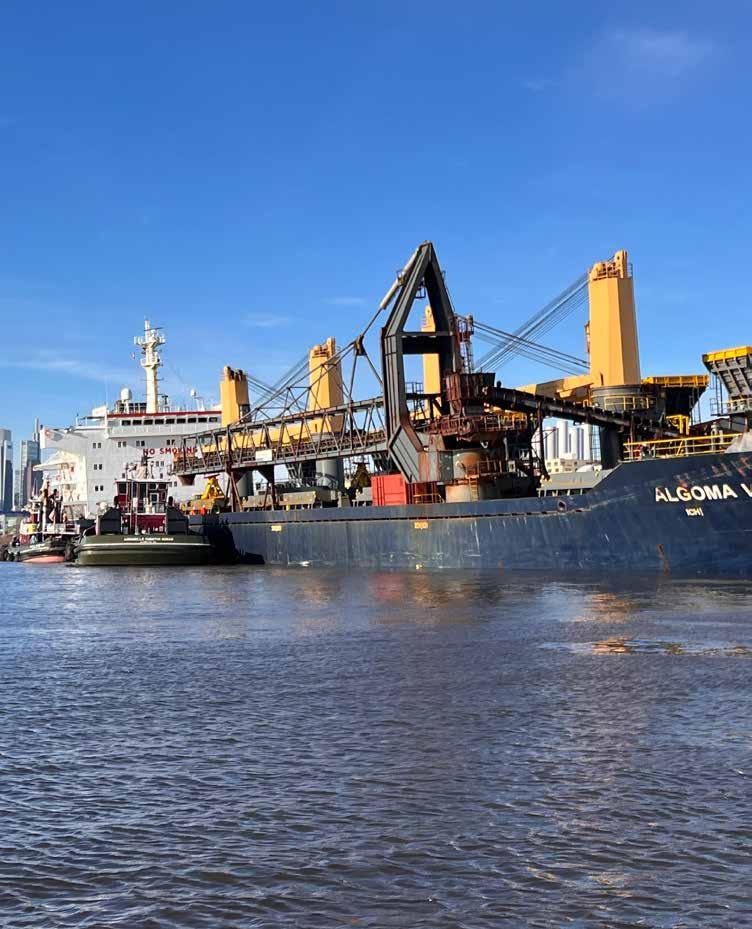
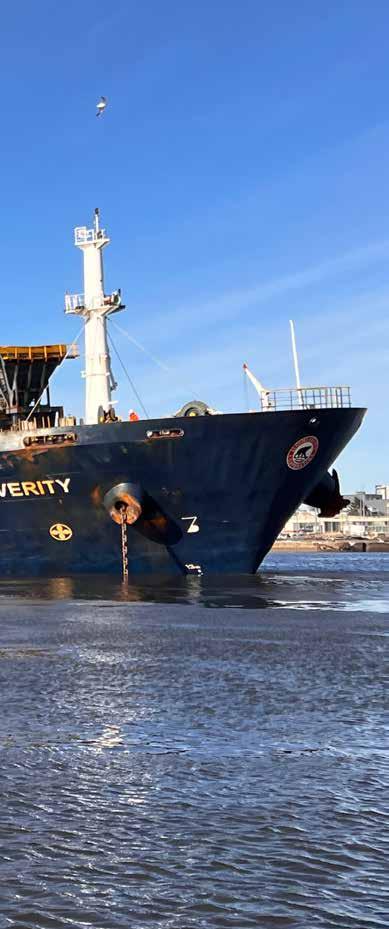
Run aground
The US Coast Guard responds to the aground 623-foot bulker, Algoma Verity, approximately a mile north of the Benjamin Franklin Bridge in Philadelphia.
The vessel was northbound with a cargo of approximately 45,000 tons of solar salt when it ran aground on January 8, 2025. No injuries were reported. It was successfully refloated days later and then taken to Tioga Marine Terminal approximately two miles north of the bridge on the Delaware River.
The location is just a short distance from another major incident in the US last year, following the collision of the container ship MV Dali with the Francis Scott Key Bridge in Baltimore on 26 March. The incident left six construction workers dead who were working on the bridge at the time with others injured after the structure collapsed into the waters below.
Other incidents have meant it has been a busy year all round for salvors worldwide.
These include firefighting on the containership Maersk Frankfurt following an explosion onboard that left one crew member dead. Fire crews were also called into action on the Greek Sounion tanker after it was targeted by Houthi rebels in the Red Sea. Work also entailed the transfer of crude oil onboard from the stricken tanker. MV Ultra Galaxy, a Panamaregistered cargo ship, also ran aground last year off the coast of South Africa.
In Baltimore, meanwhile, plans are underway to construct a replacement bridge, which will be taller and better protected against ship strikes. The MV Dali has since returned to service following repairs at a Chinese yard.
In the case of Algoma Verity, the cause of the grounding is still under investigation with a safety zone established around the ship, restricting vessel traffic at the Tioga Marine Terminal.
The vessel, which operates on the coasts of the Americas, is owned by Algoma Central Corporation and commercially managed by CSL as part of the CSL International Pool.
“The vessel is now well out of the channel, but we still have work to do to get the Algoma Verity safely out of the port,” Capt. Kate Higgins-Bloom, captain of the port and commander of Coast Guard Sector Delaware Bay, stated in an update soon after the vessel had been relocated. “We are thankful for the flexibility of all our port partners as we work to protect public safety, the marine environment and commerce.” ■
Pictured: US Coast Guard comes to the aid of the Algoma Verity after it ran aground earlier this year.
Photo: US Coast Guard (Petty Officer 1st Class Jacob Northup)
REGIONAL FOCUS EAST AFRICA
Emerging markets
Over the past decade, the development of East Africa’s main ports, notably Dar es Salaam in Tanzania and Mombasa in Kenya, has gained strategic significance for the wider region, though a complex interplay of economic, political and historical factors continue to undermine development
VLAD VOROTNIKOV
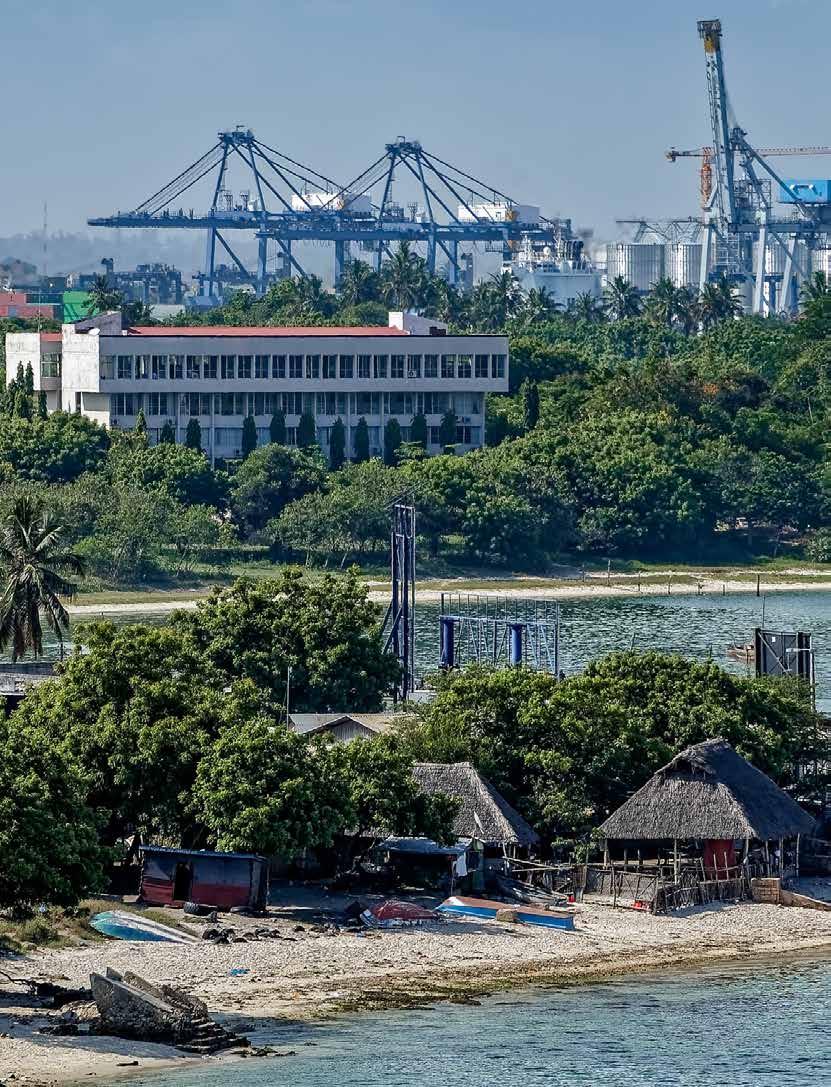
Over the past year, East Africa’s two largest seaports have enjoyed an outstanding rise in cargo turnover.
In 2024, Port of Mombasa handled a total of 41.1 million tonnes of cargo against 35.98 million tonnes in 2023, which reflects a growth of 5.1 million tonnes, or 14.1%, Sylvan Mghanga, a corporate communications manager at Kenya Ports Authority (KPA) revealed.
“In terms of container traffic, the port recorded a significant milestone, surpassing over 2 million TEUs for the first time, with a total of 2.005,076 TEUs handled in 2024. This represents an increase of 381,996 TEUs, or a 23.5% rise, compared to the 1,623,080 TEUs recorded in 2023,” Mghanga stated.
is
Pictured: Dar es Salaam, Tanzania’s main port,
set for significant investment after the signing of a number of concession agreements
Photo: Igor Groshev, Dreamstime.com

Investments in capacity expansion over the past few years have clearly paid off, though efforts aimed to streamline operations also have a role to play in the upward dynamics.
“While we have worked hard to upgrade the hardware, mostly infrastructure, through capacity expansion programmes and equipment acquisition, the area that has enabled us to bear the most fruit is the utilisation of stakeholder engagement and discussions, which has given us incredible insights for our focus, to be able to enhance customer experience in the provision of port services,” Mghanga said.
Additionally, the port's strategic partnerships and collaborations with major global shipping lines and the increased demand for goods and services in the region have also contributed to this growth, Mghanga added.
In Tanzania, cargo turnover dynamics also look impressive. In 2023/2024, Dar es Salaam handled 23.7 million tonnes of cargo, up by over 110% compared with the previous year, the Tanzania Ports Authority (TPA) revealed.
In 2024/2025, the pace of growth slowed, as between May and December, TPA’s ports handled 16.5 million tonnes of cargo, 5.2% more than in the previous year, highlighting a degree of volatility.
Dar es Salaam accounted for the lion's share of this volume of 14.4 million tonnes, which was 5.6% higher than in the previous year.
This period was also marked on 22 October 2023 by DP World signing a 30-year concession agreement to operate the multipurpose port of Dar es Salaam.
Port of Mombasa
In Kenya, Mombasa started gaining importance as a transhipment hub in East Africa back in 2016, when, with the help of Japanese partners, the port's capacity was expanded with a second container terminal and three additional berths.
Another key development was the new Standard Gauge Railway (SGR) connecting Mombasa to Nairobi, the Kenyan capital, and eventually to the Ugandan border to enhance hinterland connectivity, an initiative largely funded by China.
A new road jointly funded by the UK and Denmark has further improved port access and lowered congestion in and around Mombasa, tackling some of the infrastructure challenges that commonly face all the countries of East Africa.
Considering its importance for the country and the region, Mombasa is among the few remaining ports in Africa and the world that has not yet sought a public-private partnership (PPP), such as a landlord-type terminal concession. It is not clear whether this will change in the foreseeable future.
As revealed by KPA's Mghanga, several key initiatives at the port are aimed at further enhancing efficiency and capacity.
“These include, among other things, expansion projects, including construction of new berths at the Second Container Terminal and cargo-handling facilities to accommodate bigger vessels and increase throughput,” Mghanga said.
Further infrastructure improvements are also being prioritised, including more road upgrades to facilitate smoother transport of goods to and from the port, as well as a set of environmentalprotection measures.
In addition, there has been a shift towards digitisation of
operations with the implementation of an automated cargo tracking system and electronic documentation to streamline processes and transparency.
Dar es Salaam
In Tanzania, DP World pledged an initial investment of US$250 million as part of its landmark deal to operate Dar es Salam port, potentially rising to US$1 billion during the duration of the concession period.
Now a year and a half into the concession — a deal that had initially faced some criticism among opposition leaders who had described it as a breach of sovereignty — many local commentators see positive long-term benefits.
“Given the instability of TPA operations and the critical importance of Dar es Salaam port for the long-term viability of the SGR project, criticism of the DP World arrangement on sovereignty grounds is likely to be premature,” noted Tilmann Feltes, local representative of Konrad-Adenauer-Stiftung (KAS) in Tanzania.
Indeed, Tanzania has not handed over ownership of the port, nor do specific project agreements apply indefinitely, as shown by the 30-year term applied to the lease.
Moreover, in May 2024, a group led by Adani Ports announced a separate 30-year concession with TPA to operate and manage Container Terminal 2 at Dar Es Salaam, taking over from Hutchison Port Holdings.
The four-berth terminal has an annual cargo-handling capacity of 1 million TEUs and managed 0.82 million TEUs of containers in 2023, estimated to be 83% of Tanzania’s total container volumes.
Collectively, these concessions, and the investments they bring, are expected to further elevate capacity and efficiency levels at Tanzania’s main port and open up the region to more trade.
Long-term potential
On a broader level, both ports in Dar es Salaam and Mombasa are set to play an increasingly important role as the East African region expands, driven also by the growth of landlocked states such as Uganda, which is looking to export its sizeable oil reserves.
“Key drivers for development in Mombasa and Dar es Salaam have been attempts to widen the hinterland and private sector investment,” said Jan Hoffmann, global lead for maritime transport and ports, World Bank, adding that both ports also cater for other landlocked countries such as Rwanda, Burundi, South Sudan, plus eastern Democratic Republic of Congo (DRC).
"There is potential in African ports to benefit from the African Continental Free Trade Area (CFTA),” Hoffmann said. Launched in 2021, this is a large free-trade area spanning a market of over 1 billion people in one of the world’s fastest-growing continents. “The CFTA should lead to more demand for intra-African trade and more possibilities for cross-border investments,” Hoffmann added.
However, a mix of factors, including Africa’s historically underdeveloped infrastructure, may yet hamper the growth of trade across East Africa for the foreseeable future.
Again, neither Dar es Salaam, nor Mombasa, particularly benefited from the Red Sea crisis and the diversion of maritime traffic around the Cape of Good Hope.
“Initially, we thought this could be an opportunity to provide more
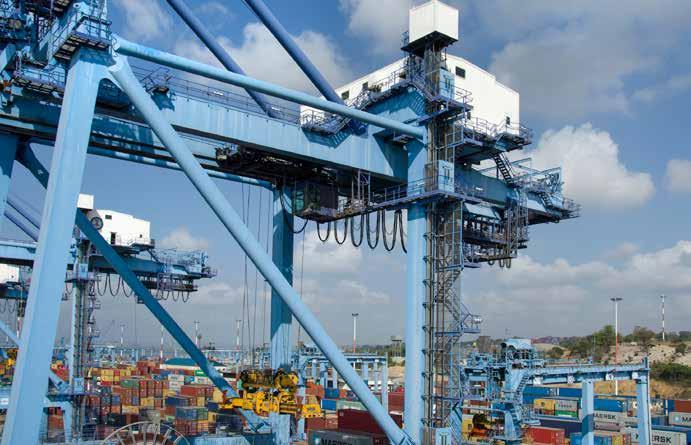
services to those additional ships. In reality, there was little bunkering and transhipment capacity to do so," one source who asked not to be identified told P&H.
Another obstacle to African port development is the prevailing lack of inter-port competition or cooperation, the source noted. Transit and trade facilitation still limit de-facto options for shippers from neighbouring countries.
“An importer in Tanzania would always go through Dar es Salaam, even if, for those in the northern part of the country, geographical distance and shipping services could make Mombasa more attractive.”
Bagamoyo project
Perhaps one of the more intriguing but lesser-known port projects in East Africa is Bagamoyo, also in Tanzania.
Nearly a decade ago, Tanzania negotiated with China Merchant Holdings International (CMHI) and Oman's sovereign wealth fund to finance and construct a US$10 billion new port and surrounding infrastructure at the town, around 45 miles north of Dar es Salaam.
Though negotiations fell through, the project has been revived under current President Samia Suluhu Hassan, who is keen to see its potential realised. Built around Bagomoyo Special Economic Zone (BSEZ), it is hoped the port might one day be able to accommodate 20 million containers annually.
There remains interest, with a Saudi-led group, Saudi African Company for Investment and Development, recently linked to signing a concession agreement with Tanzanian officials to develop the scheme as part of the so-called East Gate project.
While Tanzanian officials promptly denied any such deal it is clear Bagomoyo remains high on the agenda. The BSEZ will encompass multiple interlinked developments, including the port, industrial zones, a free trade zone, ICT hubs, plus a railway connection.
Minister of State in the President’s Office Professor Kitila Mkumbo has, however, indicated that the project would be implemented under a PPP model, with various undisclosed stakeholders expressing an interesting in collaborating with the government.
Rather than one single concession, it will be developed in several parts. "With limited prospects for a single partner and keen to avoid financial overexposure, Tanzania is now moving to split the project into different components and develop PPPs with a variety of interested parties,” said Feltes. Companies and parties from the likes of Belgium, France, Abu Dhabi, Dubai, China and the USA have all reportedly signalled an interest. However, as other parts of Africa may have learned, some foreign investments may come at an unwanted cost, according to external observers.
"This competition can result in increased political and economic influence, as well as infrastructure dependency, which East African nations must navigate carefully. It is essential for these countries to strike a balance between economic benefits and potential loss of control over critical infrastructure and their socio-economic environment in favour of long-term development goals and own national interest," Feltes pointed out. ■
Pictured: Cargo crane working at the container terminal in Port of Mombasa, Kenya Photo: Druid007, Dreamstime.com

ABOUT THE AUTHOR
BENJI MORRISON is harbour master as Port of Aberdeen, where he oversees the marine department and ensures compliance with statutory requirements for safe navigation. Previously, he served as a marine pilot and assistant harbour master at Stornoway Port.
Nine to five
Port of Aberdeen, Scotland’s largest berthage port, is playing a pivotal role in the energy transition, facilitating the shift from offshore oil and gas to wind and renewables. With so much going on, no two days are same, says harbour master, Benji Morrison
6 : 45 5 : 3 0
8 : 3 0 8 : 0 0
While the coffee brews, emails are first on my list. Next, I review my calendar, piecing together a picture of what the day will bring. I look at marine traffic and our interactive mapping software, which provides a real-time glimpse into the port’s activity. One priority is confirming the ETA for an inbound warship, the HNLMS Johan De Witt.
Head to the port. The drive is a quick one, just 10 minutes, ahead of the arrival of the warship. I arrive at the South Harbour viewing point, a prime spot to take in the scene. Port of Aberdeen’s CEO, Bob Sanguinetti, and chair, Roy Buchan, are already there, ready to observe the action firsthand.
The warship’s transit is executed flawlessly, safely manoeuvred alongside Dunnottar Quay South. Lines are run, securing the vessel in place, and the harbour tugs are released to return to their next duties. The pilot disembarks, while the ship’s port call services and requirements begin to arrive.
The day takes a collaborative turn with a Tall Ships Aberdeen 2025 meeting to align plans and present updates, setting the stage for one of the port’s most exciting future events. Afterwards, I connect with the marine pilot who guided the warship into port earlier this morning for a quick debrief.
21 : 30 17 : 30 15 : 3 0 13 : 15 12 : 30 10 : 3 0
I leave the Marine Operations Centre (MOC) and head to the warship for my 10:30am meeting with the naval liaison officers and the ship’s commanding officer, which is an honour. Coffee is served, and welcome gifts are exchanged.
I step out for a walk from the MOC to Aberdeen beach. The walk is a short one, leading me to a nearby spot for a light lunch and a coffee.
Next, a working meeting with the port’s hydrographer to review and discuss the most recent hydrographic surveys and conservancy reports for both North and South Harbours. Today’s discussion focuses on berth depths, identified features, controlling depths, the River Dee and navigational channels.
An in-person meeting with one of our stakeholders where we look into vessel port usage, feedback from their fleet, and potential upcoming requirements for mobilisation and maintenance activities. We explore their plans to diversify their fleet, transitioning into supporting the offshore renewable and wind energy sectors.
I’m home and ready for a quick change before heading out for a walk along the riverside. I then catch up with the kids over FaceTime giving me a peek into what they’ve been up to, and we talk about their weekend plans. After a quick dinner, it’s time to wind down with a bit of Blindspot on TV.
It’s then time for bed, earlier than usual since I’ve got plans for a hike tomorrow, weather permitting. If the conditions are right, it might be Bennachie or Clachnaben in Aberdeenshire. Either way, it’s sure to be a great way to spend the day outdoors.
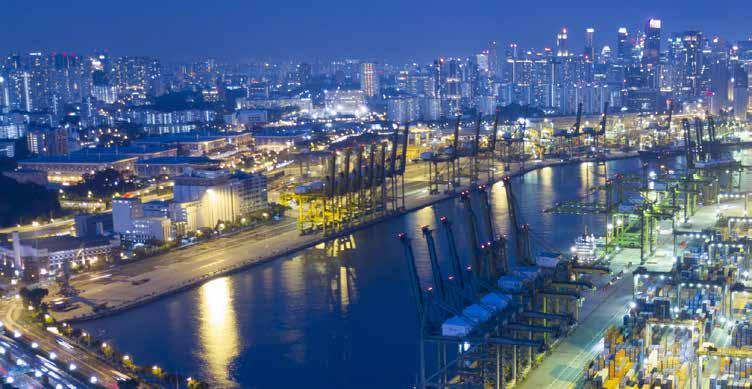
PERSPECTIVE MARITIME CITIES
Leading maritime cities driving shipping decarbonisation
Decarbonisation and digitalisation are key concerns in today’s maritime world. Both are being advanced in the world’s leading maritime cities, driving ports and shipping toward their ambitious goals.
The industry is in the midst of a major transformation. Lofty decarbonisation targets set by the International Maritime Organisation (IMO) mean the entire sector is looking at how it can undergo a transformation of technologies and fuels to reduce emissions, with much of this being supported by advances in digitalisation.
As explained in the most recent edition of the Leading Maritime Cities (LMC) report – a collaboration between DNV and Menon Economics – maritime cities are often the centres of gravity driving this forward.
This is where the leading companies
and talent are residing and where the real transformations are taking place. Leading maritime cities provide platforms for progress and serve as conduits, linking the industry with the wider global economy.
Singapore dominates the rankings with its strong decarbonisation efforts. Like the previous edition of this report, a combination of objective and subjective indicators were used to rank the various different cities. Singapore was once again recognised as the leading maritime city, followed by Rotterdam and London, with Shanghai and Oslo making up the remainder of the top five.
The Asian city-state hit the top spot in three out of five key pillars, retaining its
position as leader in Attractiveness and Competitiveness and overtaking Athens and Shanghai in Shipping Centres and Ports and Logistics. Much of this is due to Singapore’s strong positioning towards decarbonisation.
Singapore style
Driven by key bodies such as the Maritime and Port Authority of Singapore (MPA) and the Global Centre for Maritime Decarbonisation (GCMC), Singapore has a forward leaning, future-ready approach. Decision makers in Singapore look at things not just for the next few years, but for the next decade. This includes policies towards building up a multi-fuel infrastructure, the electrification of harbour craft and the promotion of green shipping corridors.
Overall, this has made Singapore an attractive location for shipping
Pictured: Singapore ranked as the world’s leading maritime city in DNV’s report Photo: Paulus Rusyanto | Dreamstime.com
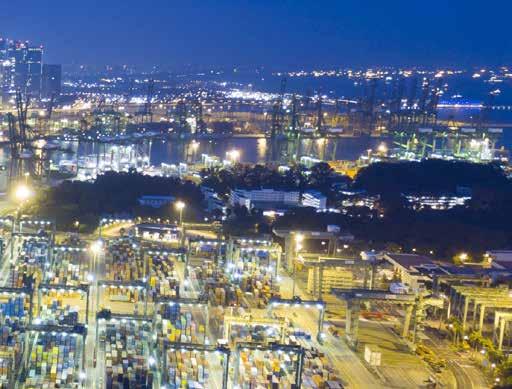
businesses, to the point where we now regard it as the Silicon Valley of the maritime industry.
As the example of Singapore has shown, strong, progressive government policy is one of the key factors behind the evolution of maritime cities, underpinning a forward-leading approach. This can attract companies and top talent to a city, while creating a competitive economic environment with well-developed infrastructure can encourage these actors to stay.
This is especially relevant for decarbonisation initiatives, where returns on investments take longer, and are dependent on wider infrastructure being in place. Government support mechanisms can be crucial in facilitating innovation, so that new products and solutions can be developed.
Talent centres
Central to the attractiveness and competitiveness of a maritime city is its ability to attract and retain top talent. The presence of research and educational institutions can help to develop talent within that location while the availability of professional opportunities and general high standards of living will encourage leading talents to relocate. This then
serves to aggregate available knowledge that could otherwise be located in silos.
With enough talent in place, conditions are ripe for research and development (R&D), a central part of the report’s Maritime Technology pillar, which in 2024 was topped by Busan in South Korea, followed by Singapore and Oslo. One of the objective indicators in this pillar is the number of maritime patents owned by companies in each city, shining a light on the success of R&D initiatives.
For an industry like shipping, where in each vessel there are so many systems and components, R&D is more important than ever. The growing importance of digitalisation amplifies this, and it is now vital to bring data analysts, AI experts, and programmers together with traditional shipping innovators so that more walls can be broken down and solutions found even faster.
Future-ready ports
With moves to decarbonise the industry underway, ports will be key cornerstones in facilitating a successful green transition. This means developing bunkering infrastructure and being ready to supply a range of alternative fuels in the future, providing shore power and building up supporting structures so that

ABOUT THE AUTHOR
Dr. SHAHRIN OSMAN is a business development director at DNV Maritime Advisory. He also serves as adjunct associate professor for industry transformation at the Singapore Institute of Technology and as director at the Maritime Decarbonisation and Smart Shipping Centre of Excellence in Singapore.
these can be delivered in a safe manner by well-trained personnel.
While much of the infrastructure for alternative fuels has yet to be developed, cities need to ensure that they have reliable processes and procedures in place today, so that when the time comes to deliver a bunkering system for alternative fuels the risk element is low.
Digitalisation will also serve in port decarbonisation. Advances in digitalisation by ports will likewise be crucial in serving the wider decarbonisation of shipping. Smart ports are leveraging digital technologies to optimise cargo-handling processes, streamline logistics operations and enhance security measures. However, different cities have varying levels of digital capability, meaning some are better positioned to deliver this than others.
Port digitalisation is also very important in promoting ‘just-in-time’ operational efficiencies, which requires ports to be able to communicate exact berthing times with vessels. Once a system like this is in place, it will facilitate speed optimisation, which can help to reduce emissions even further.
Maritime finance and law is another key pillar in the maritime value chain, an area in which London stands as the top-ranked city. ■

Chronicler of the Maritime Landscape
To mark the opening of an exhibition in Antwerp celebrating the work of Belgian artist Robert Mols (1848-1903), IAPH managing director Patrick Verhoeven explores some of the history behind a man whose creativity and talents were clearly fuelled by a passion for the sea
PATRICK VERHOEVEN
Robert Mols was a privileged witness to the transformation of the Port of Antwerp in the second half of the nineteenth century. In particular, the redemption of the Scheldt toll in 1863 triggered unprecedented growth, accompanied by major infrastructure projects, including the straightening of the Scheldt quays and the expansion of the docklands. As a result, Antwerp’s waterfront underwent a profound transformation.
Mols captured this evolution in his work, notably in several monumental harbour and roadstead views. His maritime passion was also evident in his meticulous depictions of ships, which he had been building to scale since childhood. A frequent traveller in Europe, Mols often stayed in Paris, where he had a pied-à-terre, and was a welcome guest in French port cities. He also worked in the UK, the Netherlands, Germany, Italy and Turkey.
The debate between traditionalism and modernism, which defined the last quarter of the nineteenth century, largely passed Mols by. He distanced himself from the many revolutionary artistic movements emerging in Antwerp and Paris, despite his friendships with many of their protagonists. Mols often worked on commission and generally opted for a realistic approach. His masterpieces stand out for their photographic detail and, as such, hold high documentary value — precisely what his patrons sought.
Pictured: Willem Dock with the Royal Entrepot, undated, oil on canvas, 184 x 283 cm, Antwerp, Friends of the New Maritime Museum
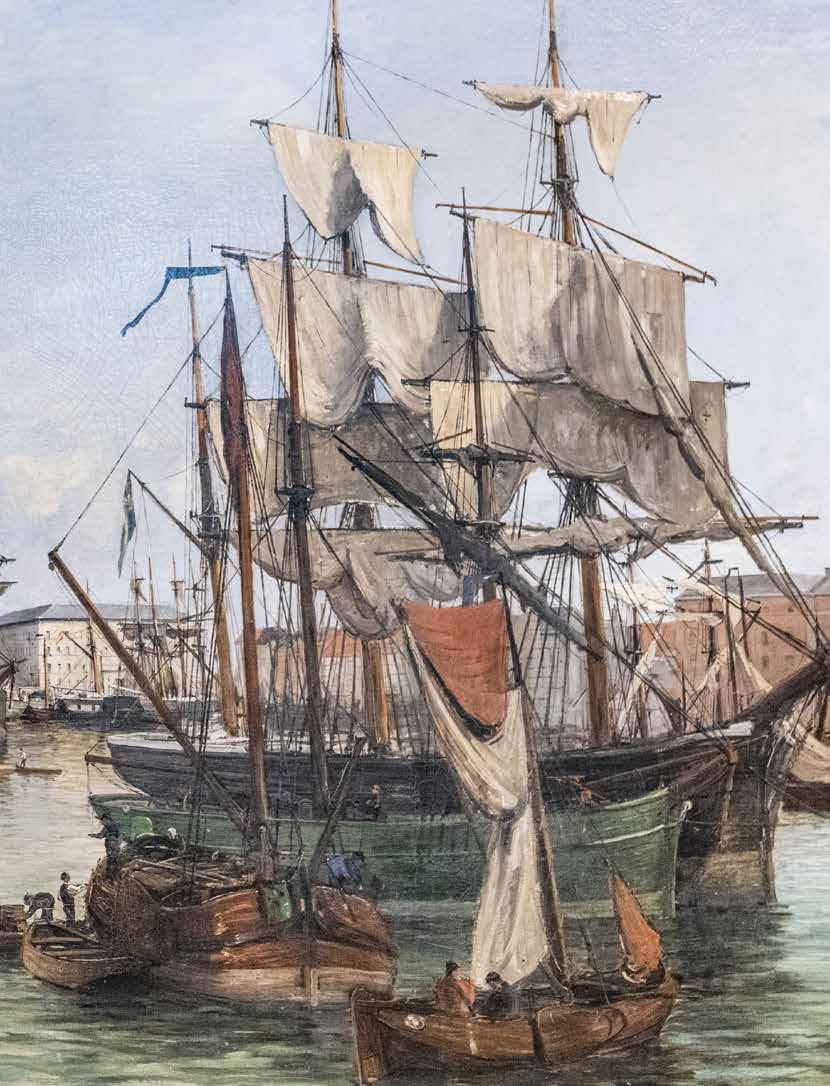
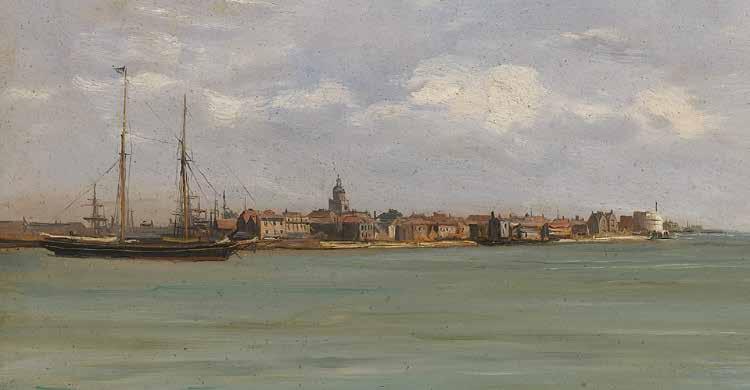

A frequent traveller in Europe, Mols often stayed in Paris, where he had a pied-à-terre, and was a welcome guest in French port cities. He also worked in the UK, the Netherlands, Germany, Italy and Turkey

Despite being a talented and prolific artist who gained some renown in his time and was in high demand, Mols' work has since faded from public attention. Little is known about his personal life, despite his aristocratic background and his presence in the highest circles of society.
With an exhibition dedicated to this remarkable artist, the first since his death to be entirely devoted to his oeuvre, the Friends of the New Maritime Museum of Antwerp
and Antwerp’s port employers’ organisation CEPA are announcing a structural collaboration aimed at sharing the Friends’ rich collection of maritime art and heritage with the wider public. ■
Robert Mols – Chronicler of the Maritime Landscape
The exhibition ‘Robert Mols – Chronicler of the Maritime Landscape’ was curated by IAPH managing director Patrick
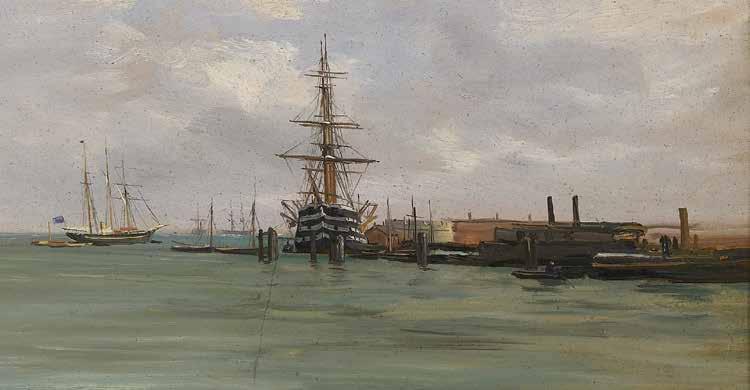
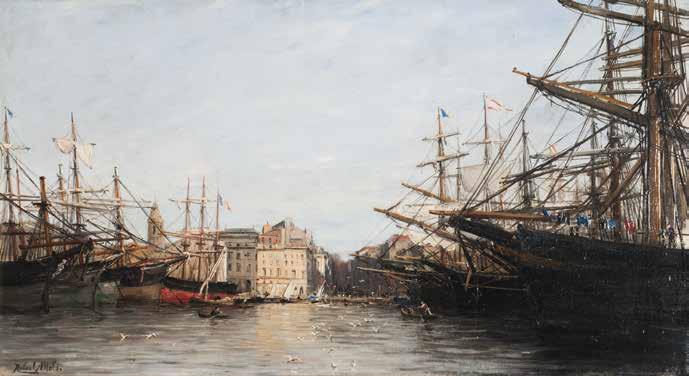
Verhoeven, who is a member of the Friends’ advisory board. He also authored a richly-illustrated monograph on Robert Mols, published by Pandora Publishers. The exhibition runs until May 25, 2025 at Zaal Anker of CEPA, Brouwersvliet 33 in Antwerp. Admission is free, and it is open on weekdays from 9 AM to 5 PM. Guided tours are available by appointment: secretaris@ vnsm.be. The monograph (in Dutch) can be ordered online from Exhibitions International (exhibitionsinternational.be)
Pictured Circled: Nadar, Robert Mols, 1890, sepiadruk, 16,4 x 10,6 cm, Antwerp, Collection City of Antwerp/Letterenhuis
Pictured Left: Robert Mols, The Antwerp waterfront in 1870, 1878, oil on canvas, 294 x 993 cm, Antwerp, Royal Museum of Fine Arts Antwerp
Pictured Above: Robert Mols, Vieux-Port Marseille, undated, 30,5 x 55 cm, Hamburg, Internationales Maritimes Museum Hamburg
Pictured Top: Robert Mols, View on Portsmouth, undated, oil on panel, 26,5 x 67 cm, Antwerp, Museum aan de Stroom
Welcome to new members
We are pleased to welcome as new members of the association:
Regular members
Port of Luanda E.P.
Angola 244 949 591 616 rmartins@portoluanda.co.ao https://www.portoluanda.co.ao/ Alberto Antonio Bengue, Chairman
Kamarajar Port Limited
India 91-44-25251666 gm-ms@kplmail.in https://ennoreport.gov.in/content/index.php
J.P. Irene Cynthia, IAS. Managing Director
P&M Consultants Pty Ltd
Australia 61 418574718 venket.naidu@portsmaritime.com https://portsmaritime.com Venket Naidu, Managing Director
Shape Associates Ltd Jersey sam.lee@shapeassociates.com https://www.shapeassociates.com Carl Appleton, Chief Operating Officer
Sentient Ports Australia agray@sentientports.com https://www.sentientports.com (pending) Allan Gray, CEO
Box Bay FZCO U.A.E. lim.mengyong@boxbay.com https://www.boxbay.com/ Christoph Roth, CEO
12
MARCH 12
IAPH Webinar Series
Impact of geopolitical changes on ports: what does this new landscape mean for trade?
iaphworldports.org
New faces
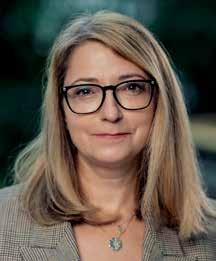
VINETA RUDZITE
IAPH would like to welcome Vineta Rudzite as our new legal counsellor. Since 2021, she has been working at The Freeport of Riga Authority, where her responsibilities include providing legal and administrative support to the CEO, risk management and the implementation of ISO standards. Vineta has extensive experience in the transport industry, having also worked at the State Joint Stock Company Latvian Railways for nine years, including in the role of deputy director of the legal department. Her legal expertise extends to previous roles at Lattelecom and Latvian Shipping Company, as well as administrative experience at the Ministry of Foreign Affairs of the Republic of Latvia. She steps into the new role vacated by her former colleague and deputy CEO Martinš Ziemanis, who has now been appointed as managing director of Stena Line Ports Ventspils AS and who has been IAPH’s legal counsellor since May 2019.
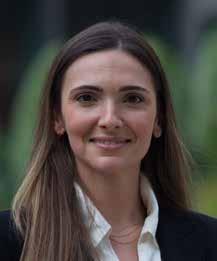
INGRID BOQUÉ
And a warm welcome to Port of Barcelona’s Ingrid Boqué who has been appointed as chair of the IAPH Data Collaboration Committee (DCC). She will join vice-chair Gadi Benmoshe of Marinnovators in leading the committee. Ingrid was highly active with IAPH in her previous role as global strategic networks officer for the Hamburg Port Authority. She managed the chainPORT initiative, which brought the world’s leading international ports together to collaborate on digital transformation. Ingrid also played an instrumental role in the IAPH 2024 World Ports Conference last October in Hamburg. She assumed her new role as director of institutional relations at the Port of Barcelona last October. Ingrid steps into the DCC chairperson’s role occupied since November 2020 by Pascal Ollivier, president of Maritime Street, who initiated the industry-wide call to action during the pandemic to accelerate the pace of digitalisation.
26
MARCH 26-28
IAPH Technical Committees
IAPH technical committee meetings at the International Chamber of Shipping, London
iaphworldports.org
14
MAY 14
IAPH Webinar Series How to deal with port infrastructure adaptation challenges with extreme flooding and drought? iaphworldports.org
Associate members

Recently appointed IAPH senior manager, Data Collaboration and Risk & Resilience, Chloe Rowland talks to P&H about her new role and previous work in areas such as port cybersecurity
Q: Can you tell us about your background?
A: I originally qualified as a commercial litigation solicitor and also have a degree in European Studies with French and Spanish. I worked as a lawyer for about eight years which really honed my ability to work under pressure. Then, while my children were little, I chose to step back from the legal world and moved instead into project management at the University of Plymouth for a better work/life balance. I’ve worked at the university for 15 years now. Initially, I was managing the delivery of the academics’ commercial consultancy contracts, but more recently I have focused on the maritime cyber security research in which the University of Plymouth leads the world.
Q: What other work and activities are you involved in?
A: I believe IAPH and its members can benefit from my links with the research team at Plymouth, so I am intending to retain a small role with the university alongside my new IAPH role. When I’m not working, I can often be found in a muddy field somewhere in England digging trenches with fellow archaeology enthusiasts looking for ancient artefacts.
Q: What involvement have you had with IAPH in the past?
A: IAPH has long been on my radar, particularly as the ‘go to’ place for sharing industry best practice. For the past four years, I have organised a Maritime Cyber Security Symposium in partnership with the IMO at their London HQ in which IAPH representatives have participated. I have also done the same at IAPH events
alongside colleagues from the Plymouth academic team, including several immersive maritime cyber ‘tabletop’ workshops at last year’s IAPH conference in Hamburg.
Q: What are the main challenges we face in the area of port cybersecurity?
A: First, a genuine lack of awareness of the scale of the problem: the myriad different ways in which a cyber incident may manifest itself (often nowhere near the time of the actual attack which makes forensic analysis difficult), countless different attack vectors and an ever-evolving portfolio of possibilities. Secondly, a kind of ‘fear’ of knowing where to start with addressing the issues, which can result in inaction or indecision and hamper positive steps forward. But I’m a person with lots of drive so I am keen to help members work together to meet these challenges head on.
Q: Tell us about your new role at IAPH?
A: Well, to a certain degree, I will be taking cues from IAPH colleagues and members as to how I can best utilise my skills to help. I will also be supporting the chairs and vice chairs of the Data Collaboration and Risk and Resilience technical committees in creating value-added deliverables to IAPH membership and work closely with my colleagues to further develop the initiatives taken so far at the IMO’s trade facilitation and security divisions.
Q: What do you hope to achieve in this new role?
A: I hope to bring an extra level of cohesion and strategic leadership to the great strides IAPH is already making in the complex and challenging fields of Data Collaboration and Risk & Resilience. I’m intending to do this by helping lead coordinated efforts to further strengthen relationships among member ports and provide platforms for discussion spaces in these critical areas of operation so we can, together, proactively collaborate with other organisations to advocate for practicable and achievable solutions for the benefit of the global community. ■
Email Chloe Rowland at: chloe.rowland@iaphworldports.com
Three organisational factors make IAPH an effective representational body for world ports: its standing as a recognised NGO, its consultative status with crucial international organisations, and the fact that it operates on a truly global basis. In the association’s infancy, each of these features represented a long-term institutional goal, and all three milestones were reached around the time of the organisation’s 10th anniversary – marked by the Fourth Conference of the IAPH, which took place in London in May 1965.
The event was chaired by Viscount Simon of the Port of London Authority with HRH The Duke of Edinburgh as its patron, and saw double the attendees of the previous conference. This growth mirrored the organisation’s rapid membership expansion, particularly with regard to European ports; until this point, “Europe had been a hard nut to crack for IAPH”, remembered secretary general Gaku Matsumoto.
Discussions at the conference emphasized cooperation with global organizations like the UN, World Bank, and OECD, to aid developing countries.
J N Bathurst, a representative of the UN Economic and Social Council (ECOSOC), spoke at the conference and outlined the procedures for establishing a relationship. The next year, IAPH was
IAPH goes global
In the second of a series of articles marking IAPH’s historic 70th year, P&H looks out how the association avoided disaster amid the economic upheavals of the early 1970s while cultivating truly global influence
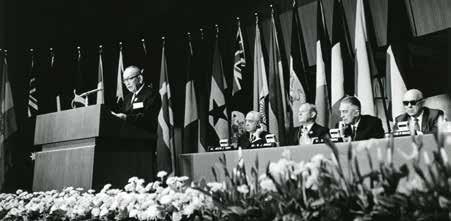
granted Category B non-governmental advisory status by the UN and went on to acquire consultative status with organizations such as UNCTAD and the IMO (then IMCO).
In recent years, London has increased in importance for the association. It is the home not only of the IMO but also of the IAPH Europe team, with a shared office space at the Park Street headquarters of the British Ports
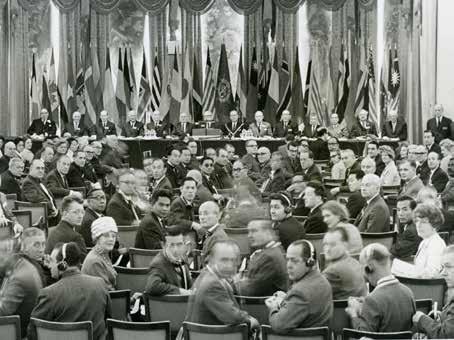
Association; it has also become the venue for the annual in-person Technical Committee days. These developments represent the continuation of a proud legacy of international engagement; as Matsumoto later observed, “it is not too much at all to say that IAPH became a world organization only by dint of the London conference.”
Mayor of Kobe takes the helm IAPH returned home to Japan for its 1967 conference held in Tokyo – an event that was approached as a matter of national importance by the Japanese government. The minister of transport was appointed as chairman of the organising committee and 20 IAPH representatives were received by the Emperor and Empress at the Imperial Palace.
Appropriately, the conference saw the mayor of Kobe, Dr Chujiro Haraguchi, elected president of IAPH. Haraguchi had been instrumental in Kobe’s selection as the venue for the first conference. He had also spent nearly two decades developing Kobe into an
Pictured Above: Dr Chujiro Haraguchi addresses the 1967 IAPH Conference in Tokyo Pictured Left: Delegates at the 1965 IAPH Conference, held in London All photos: IAPH
international city, enhancing its transportation infrastructure and ensuring the modernisation of the port facilities, preparing the city for the global industry shift to containerisation.
Faced with surging membership, the Tokyo head office modernised its operations, relocating its head office to larger quarters and consolidating the organisation’s communications so that its newsletter was merged with the quarterly Ports & Harbors magazine to create a single monthly publication. The magazine – like the association’s strong links to the city of Kobe – remains an enduring strength of IAPH to this day.
An endangered association
By the end of the 1960s, following years of tireless development, IAPH was internationally established and boasted a growing membership. Yet such progress did not immunise the association against the global economic trends that characterised the early years of the next decade. In fact, IAPH was particularly vulnerable to the twin challenges of the 1971 ‘Nixon Shock’ – which saw the US president abandon the Gold Standard –and the 1973 oil crisis. These factors jeopardised both the Association’s finances and its location: since the IAPH headquarters in Japan received membership dues in US dollars, the appreciation of the yen led to a decline in revenue when converted to yen and a relative increase in operating costs.
Taking inspiration from the funding activities of Japanese maritime foundations, secretary general Toru Akiyama (who had succeeded Gaku Matsumoto in 1967) moved to establish an IAPH Head Office Maintenance Foundation. Established by donations from Japan, it would be incorporated under Japanese law to operate the head office, funded by membership dues, other IAPH income, and funds from companies or organizations within Japan. His proposal received basic approval by the executive committee in Lisbon in May 1972, and the head office received authorization from the Japanese government to move ahead in January 1973. Following the approval of the Executive Committee at an
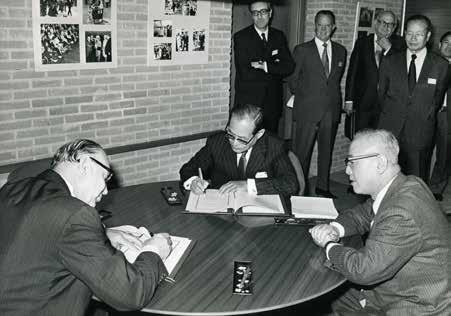
extraordinary meeting in San Juan, Puerto Rico, all that remained was approval at the next IAPH conference, held in Amsterdam in May 1973.
This was a critical juncture for the Association: if the foundation was not secured, then a substantial increase in dues was inevitable — the third increase in as many years. This might result in the dissolution of the IAPH. Akiyama’s emergency motion explained that the appreciation of the Japanese yen following the Nixon Shock, and the high rate of inflation prevailing in Japan, “posed grave financial difficulties for the Association”. The proposal was approved by unanimous vote and representatives from the IAPH and the Foundation put their signatures to the agreement, which was to come into effect in June 1973.
IAPH’s future was secure.
The era of expansion
In the wake of these changes, the work of the association’s committees became more specialised and ambitious. At the Singapore edition of the conference in 1975, a new committee was established to increase membership levels and elevate IAPH’s global prestige, while at the Houston Conference in 1977, a
special committee on community relations was established to study methods of ‘achieving community understanding of the role of ports’. By the time delegates gathered at the Casino de Deauville near the Port of Le Havre in France for the 1979 conference, IAPH’s special committees were meeting monthly and generating significant policy outcomes.
The theme of the Le Havre conference (which attracted nearly 500 delegates from 66 countries) was ‘the Future of World Ports’. The keynote was delivered by economist Wassily Leontief, the 1973 winner of the Nobel Memorial Prize in Economic Sciences. In his address, Leontief noted that the volume of world trade would ‘probably quadruple between the years 1970 and 2000’ and that ‘a similar increase in capital investment is necessary, and can be expected to bring commensurate benefits.’ His presentation made a deep impression on the audience; the question-and-answer session that followed lasted for nearly an hour, as delegates turned their thoughts to the dawn of the 21st century.
The deaths of founding fathers Gaku Matsumoto in 1974 and Chujiro Haraguchi in 1976 had signalled the end of the organisation’s infancy, yet IAPH was approaching its quarter-century with vision, confidence and a growing international reputation. ■
Pictured: (L-R) IAPH president A L King, IAPH foundation chairman Toru Akiyama, and incoming IAPH secretary general Hajime Sato signing the service agreement in 1973
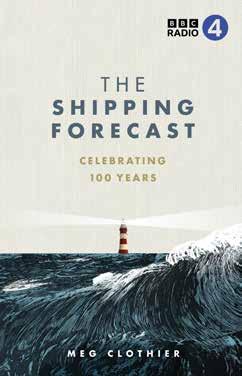

BOOK AUTHOR
MEG CLOTHIER studied Classics at Cambridge, sailed from England to Alaska and worked as a journalist in London and Moscow. She has published three historical novels and also Sea Fever: A Seaside Companion, a book full of marine lore and seaside charm, with her brother, Chris.
THE REVIEW
The Shipping Forecast: Celebrating 100 Years
MARTIN CLARK
The IAPH may be 70 years old this year, but The Shipping Forecast — the much-loved BBC radio weather programme that has captured the imagination of listeners and seafarers alike — trumps that by a few decades.
It is a programme that has been keeping people up to date with the latest changes to British weather for a century, not just sailors and skippers, but also armchair travellers and even a new generation of sleep-deprived music lovers too.
In more recent times, extracts from the programme have been put to music to create stunning soundscapes for bedtime, evoking the majestic mystery and magic of the sea to smooth the passage to sleep for weary souls in the dizzying times of 2025.
Most importantly, since its very first
broadcast, the show has provided a real and important service for those who might otherwise fall prey to storms and gales around the British Isles.
This book is being released to celebrate the show’s 100th anniversary, that’s a century of keeping BBC Radio 4 listeners up to date on all things weather, come rain or shine.
A charming companion to mark the centenary of this much-loved and long-running broadcast show, The Shipping Forecast: Celebrating 100 Years is a great addition to the libraries of all those with an interest in the sea.
Indeed, they say there’s a sea lover in every Brit — understandable, perhaps, for an island nation and one with a such a long maritime history — and this book certainly echoes that sentiment.
The only official book celebrating the centenary, The Shipping Forecast
takes you to the heart of what this enduring programme means to the nation, almost like an institution in its own right. It has even been dubbed a ‘national treasure’ by some BBC Radio 4 listeners.
In the book, Meg Clothier, a journalist and sailor, takes the reader on a fascinating exploration of British maritime history, from the stormy weather up above to the seabed far below and from fishing boats to the art, songs and poems inspired by the forecast.
Whether you’re a long-time fan of this beloved institution or a newer weather enthusiast, the book invites all to sail away into the enchanting world of the forecast. The perfect companion for anyone curious about the great skies and seas that surround the British Isles.
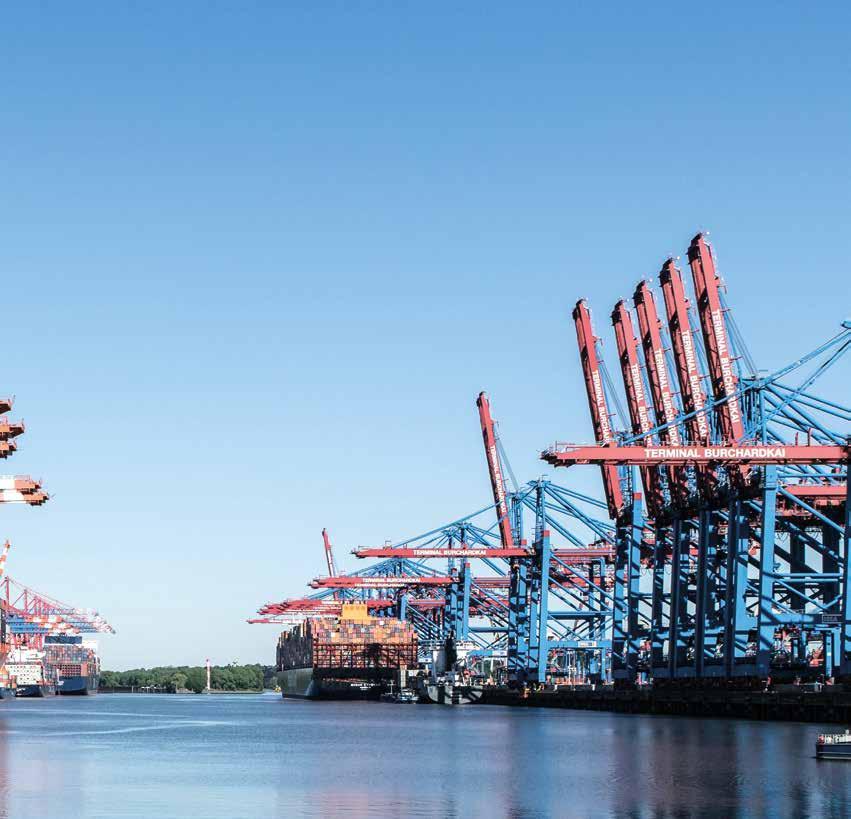


7 – 9 October 2025
Kobe, Japan
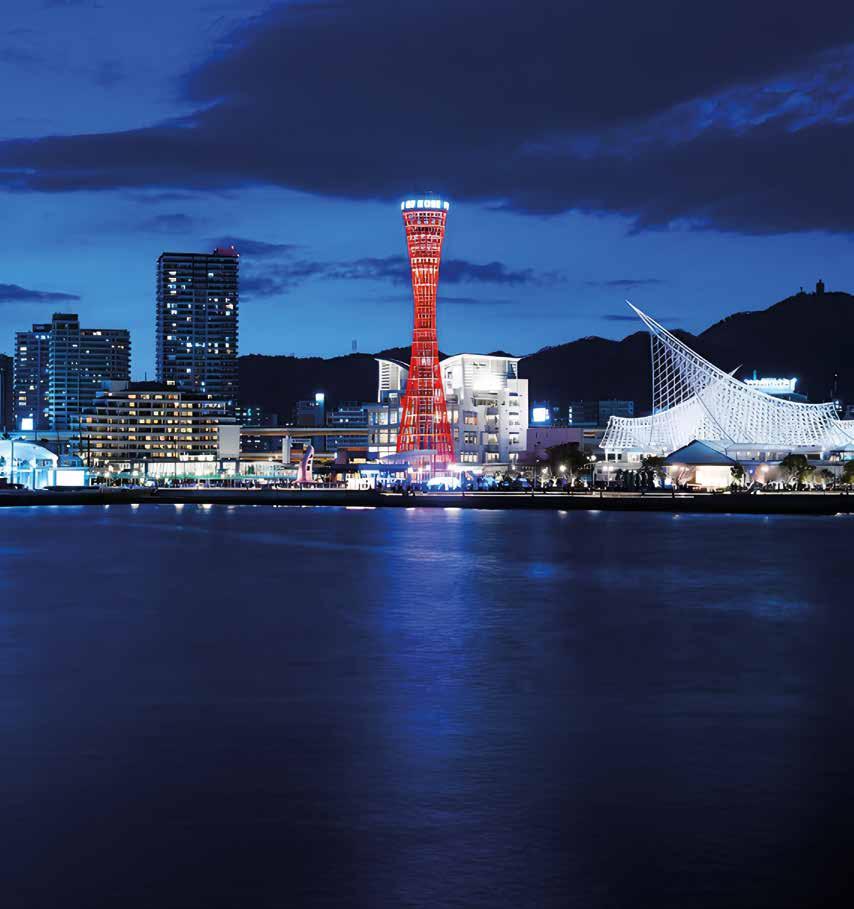
BOOK NOW
As the Association celebrates its seventieth anniversary, IAPH looks forward to welcoming you to Japan and the city of Kobe, where its roots can be found. Following the symbolic idea of establishing world peace through world trade, and world trade through world ports, this 70th annual meeting at the #IAPH2025 World Ports Conference will reunite global port leaders with their counterparts from policy makers, financial institutions, ship and cargo owners, and service providers, delivering a forum for networking, knowledge sharing and debate.
To secure your delegate place or further information on attending/sponsoring contact the events team:
visit: worldportsconference.com contact: +44 1329 825335 or email: wpc@mercatormedia.com #IAPH2025
Host sponsor:
Bronze sponsors: Silver sponsors: Gold sponsor: Award sponsors:
